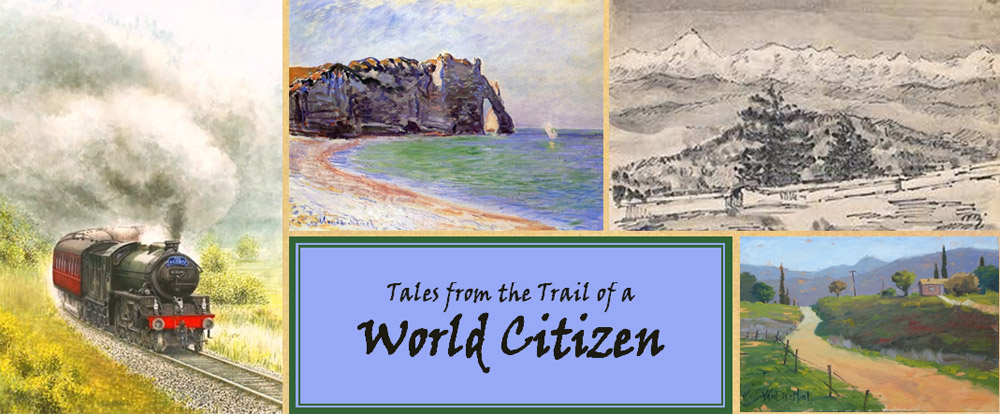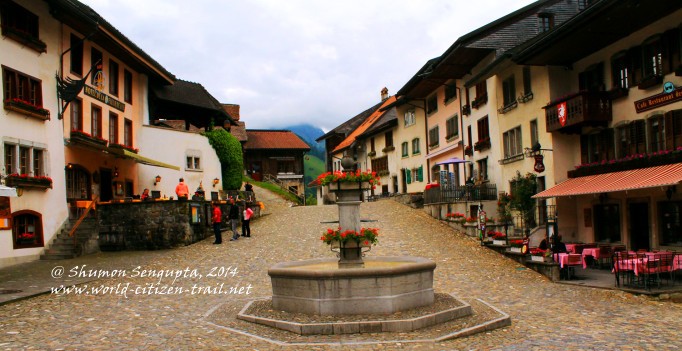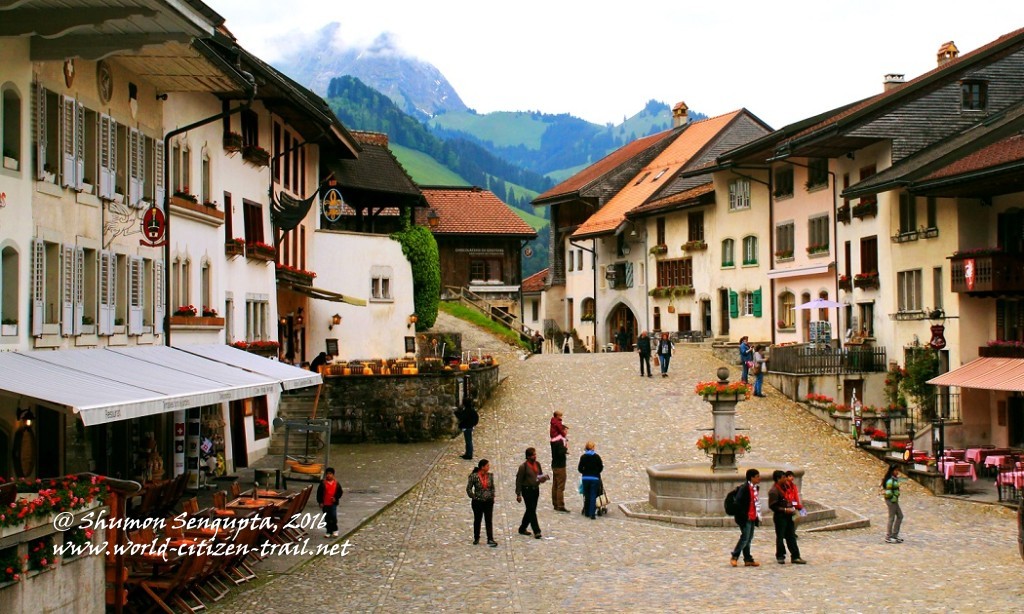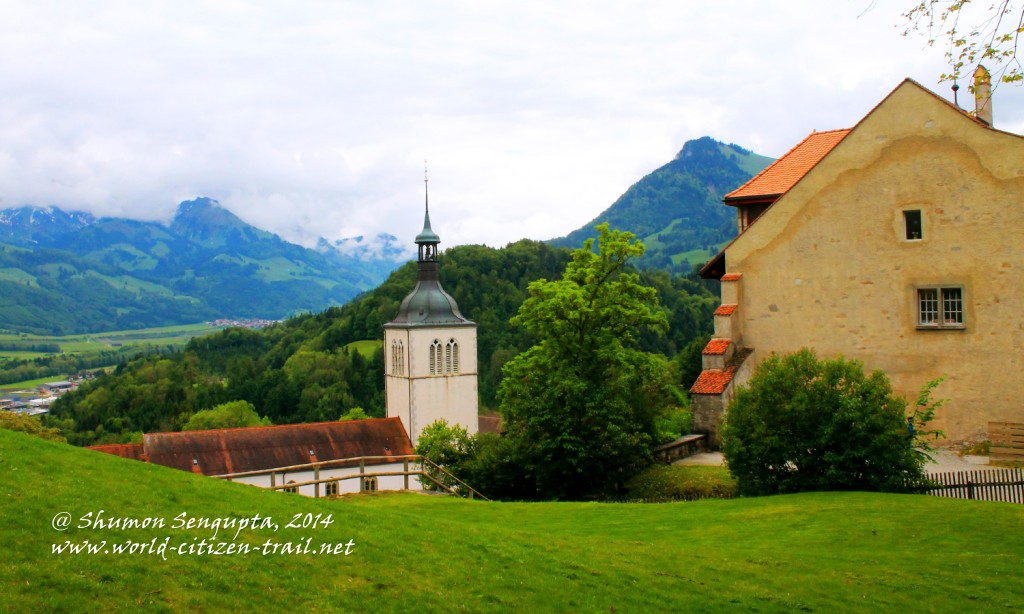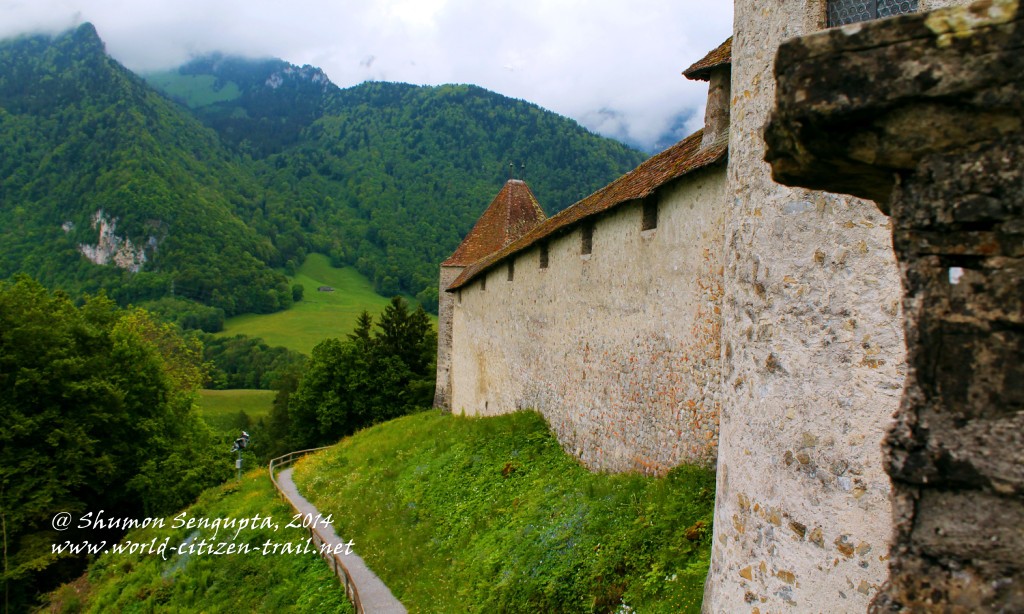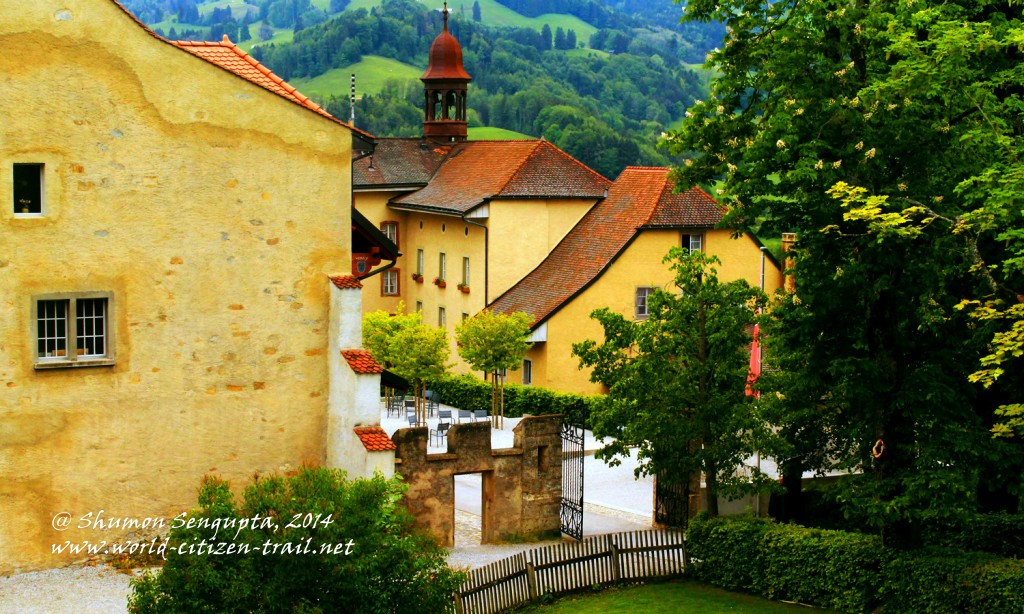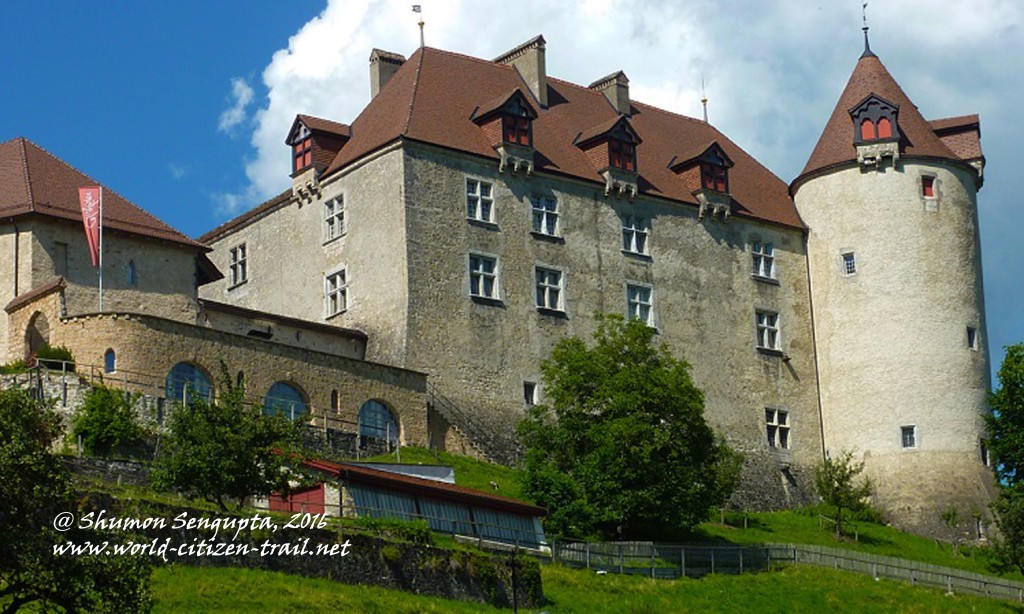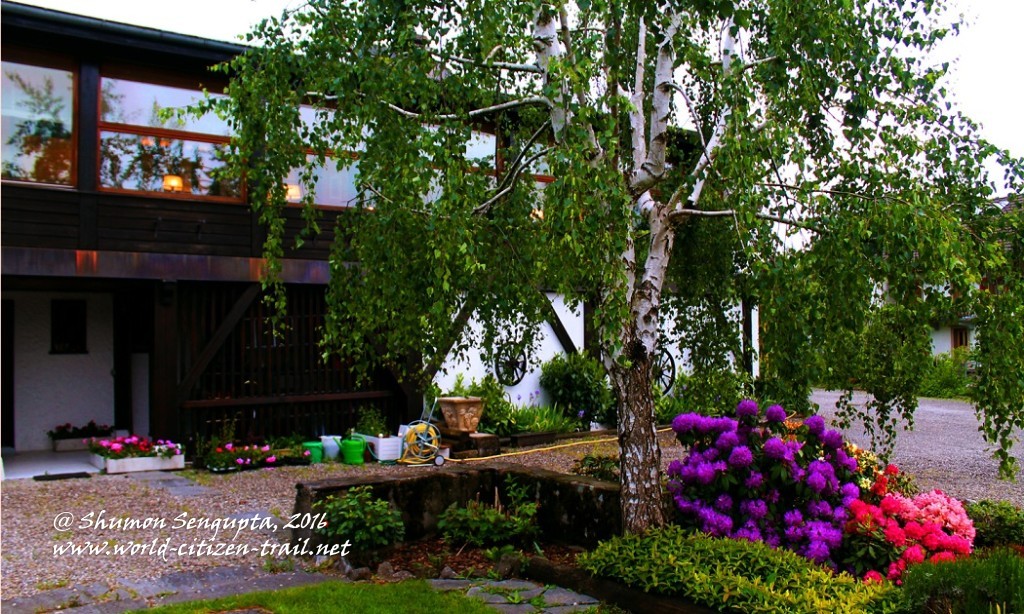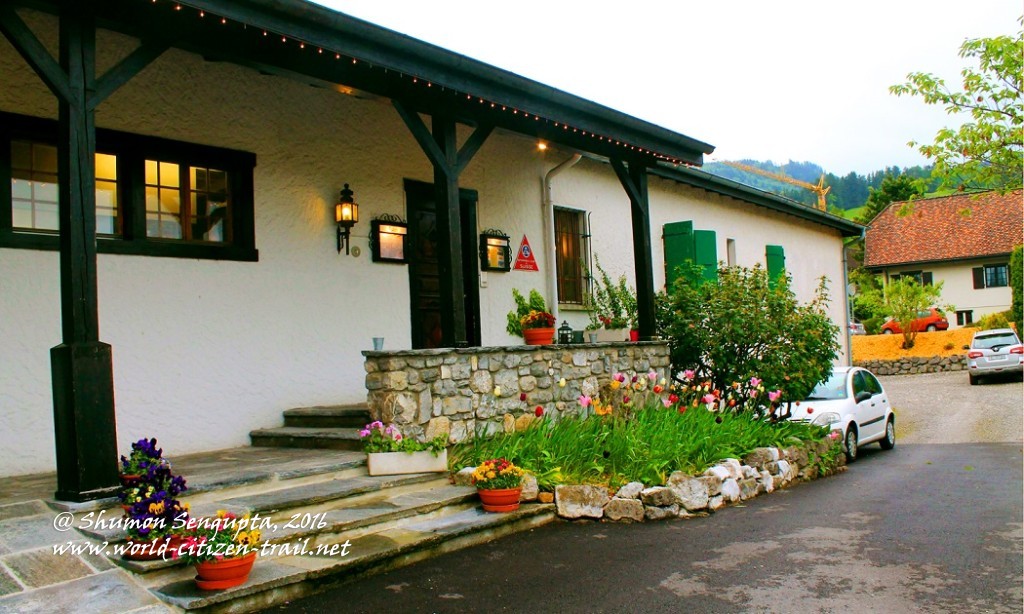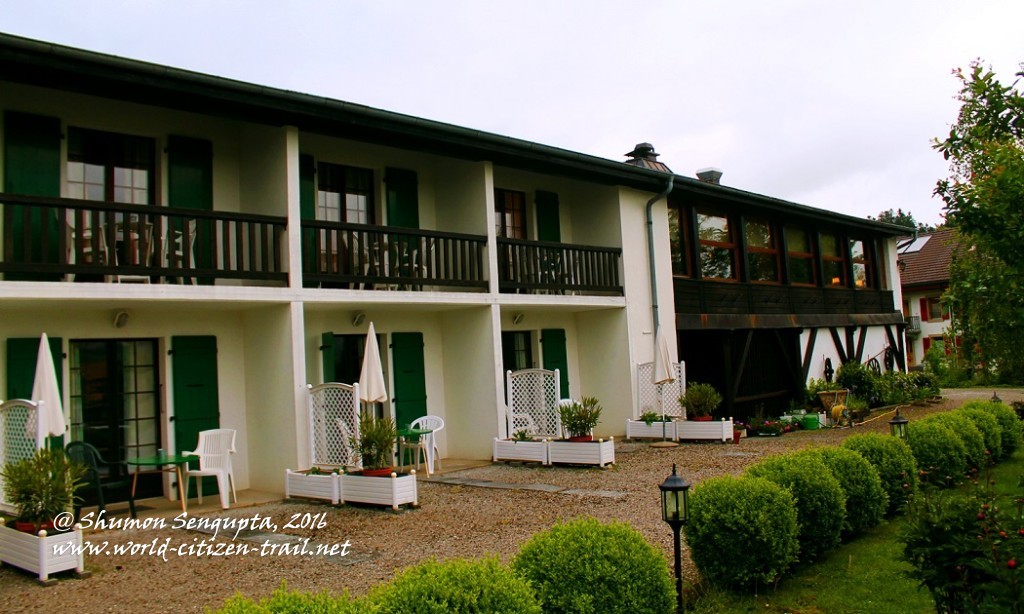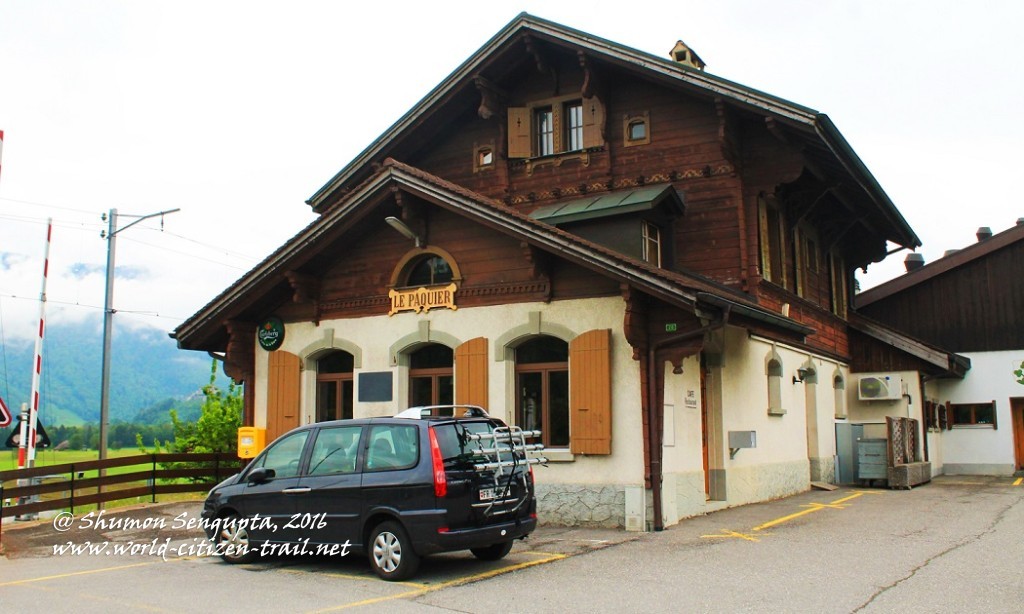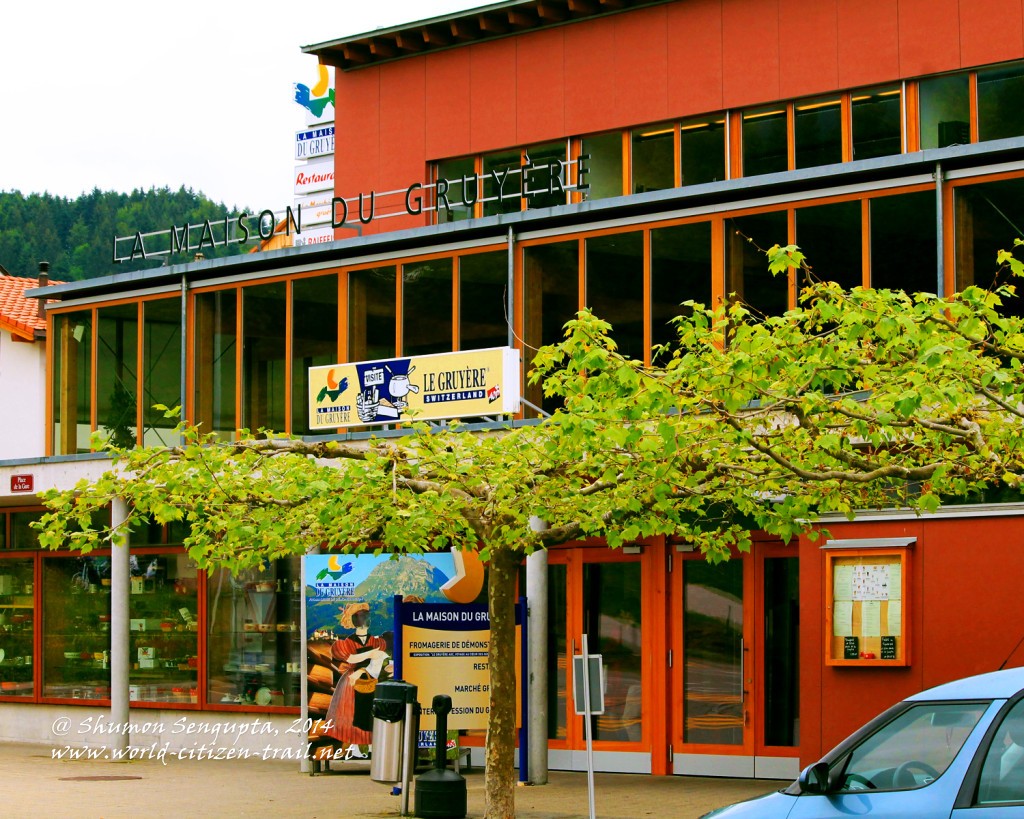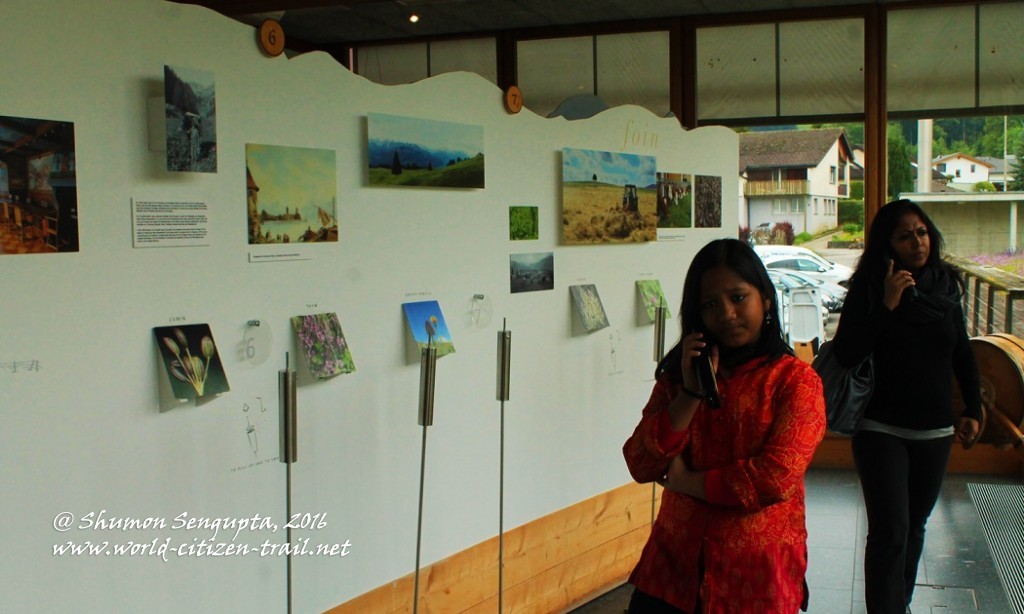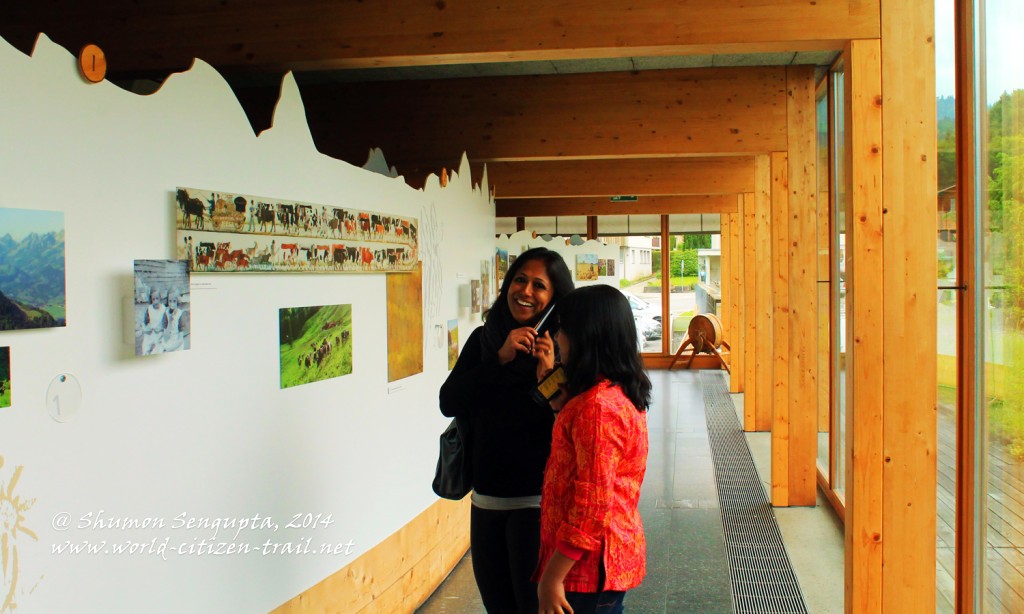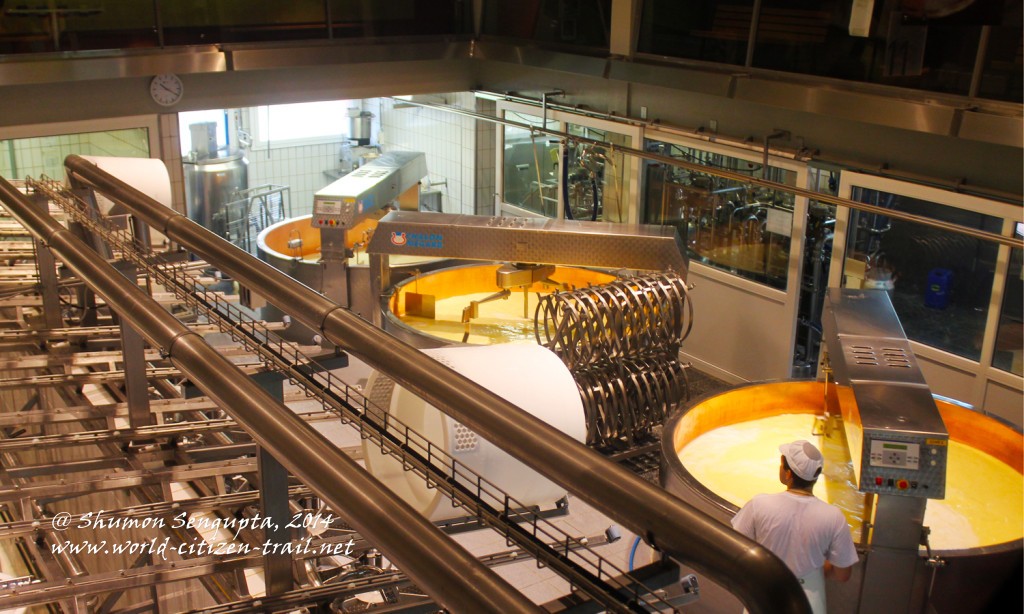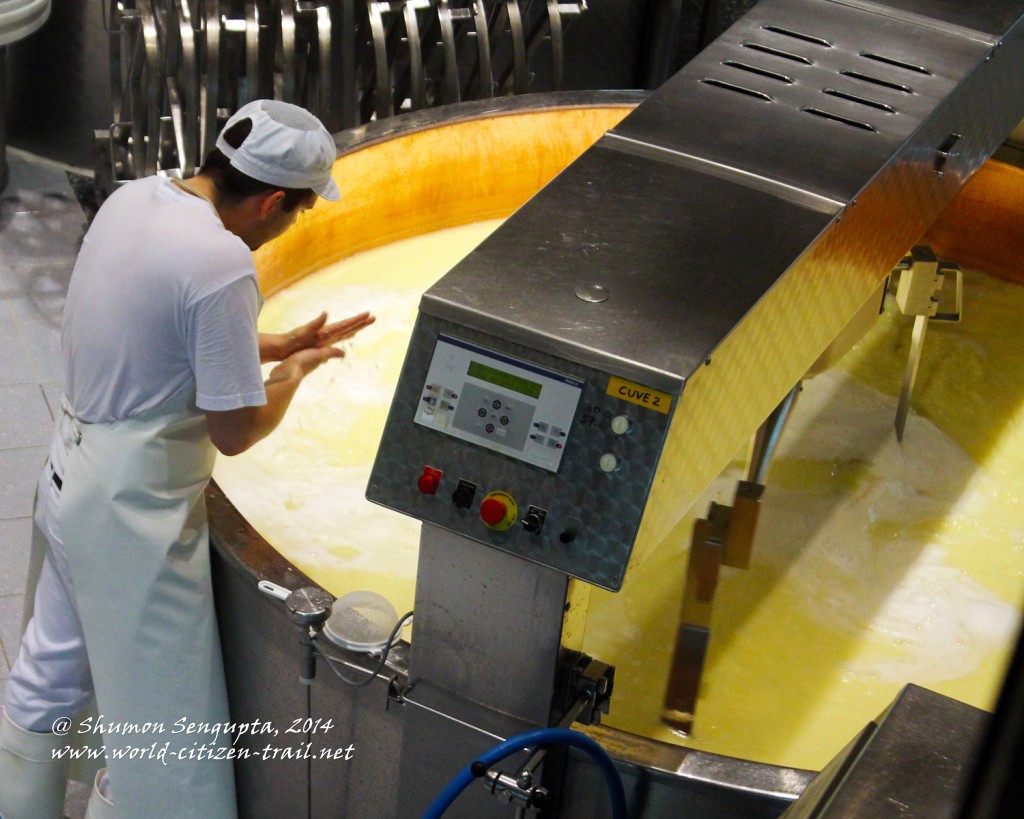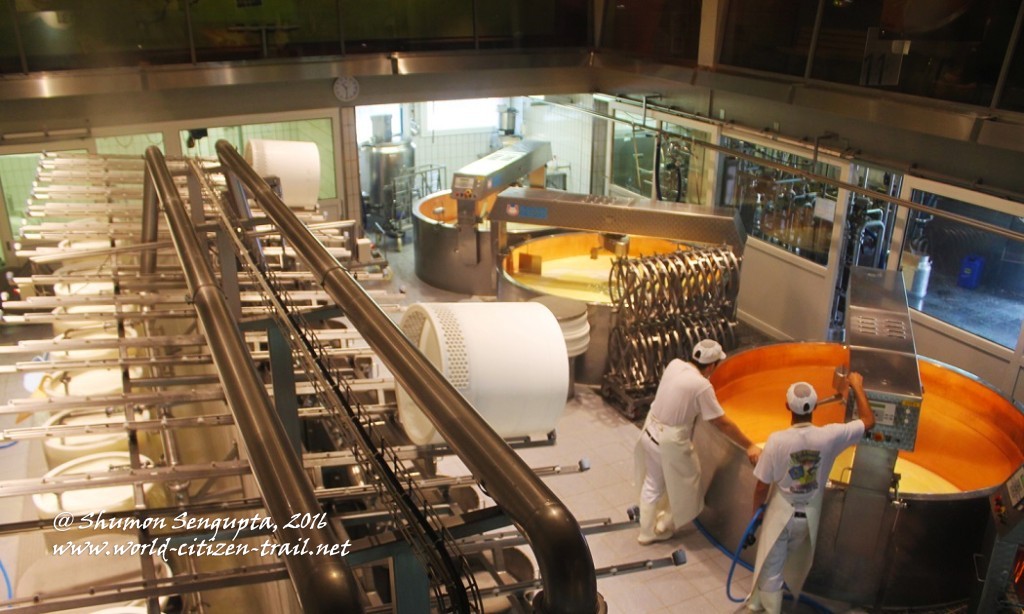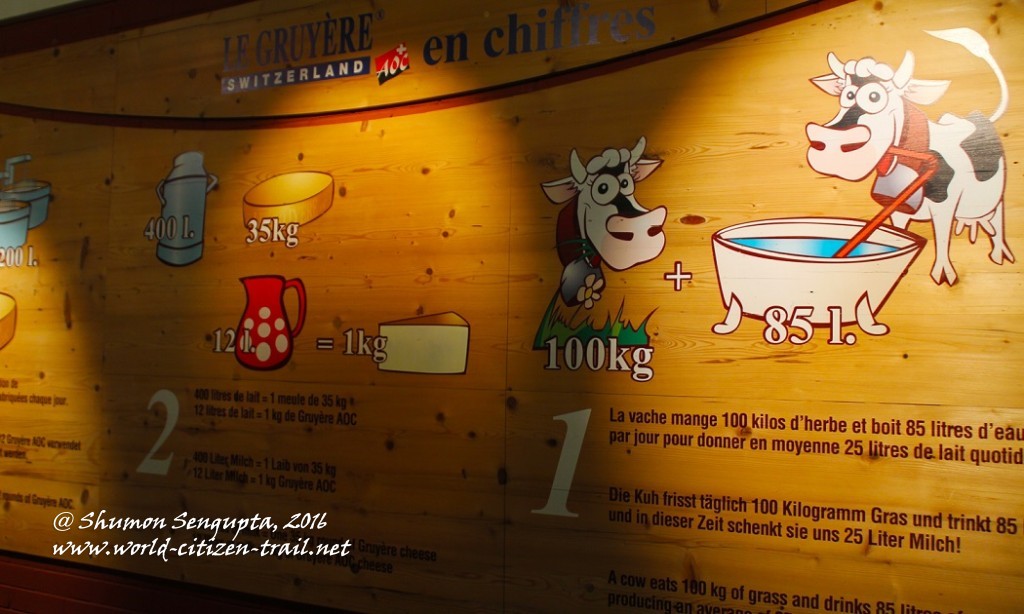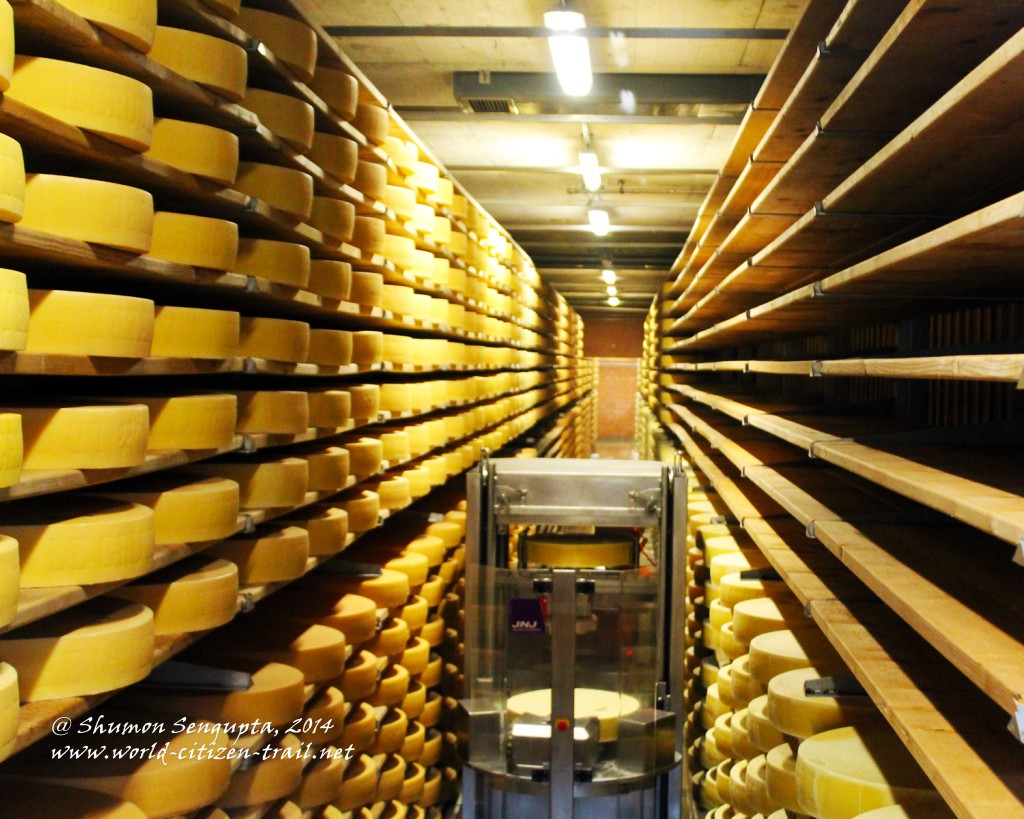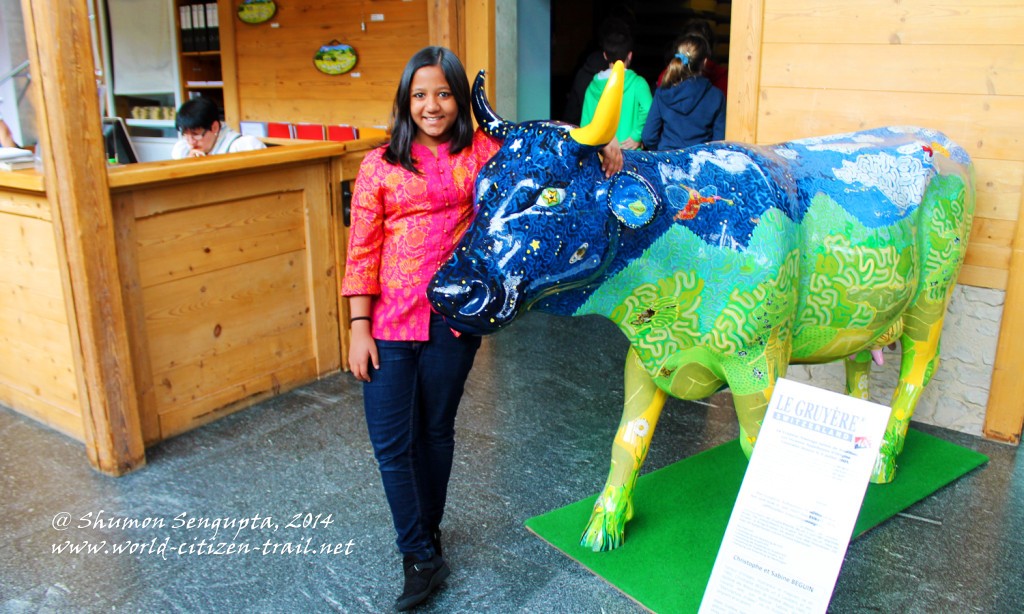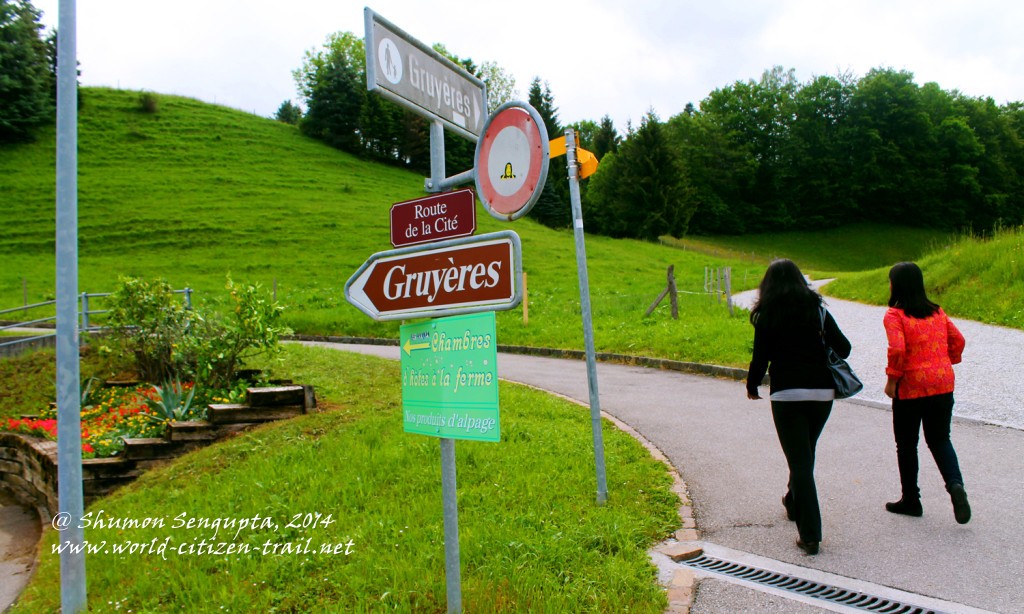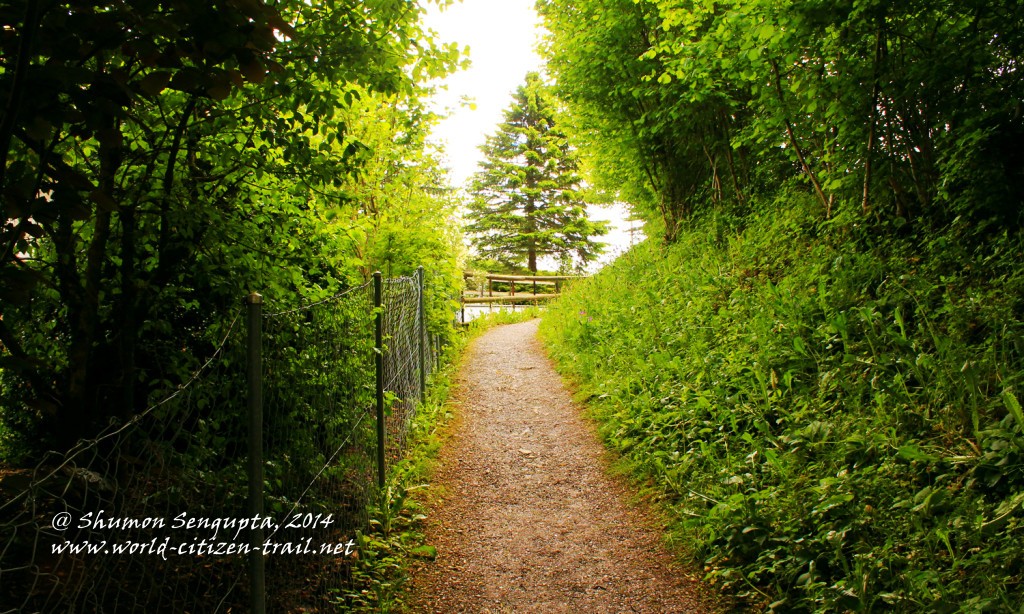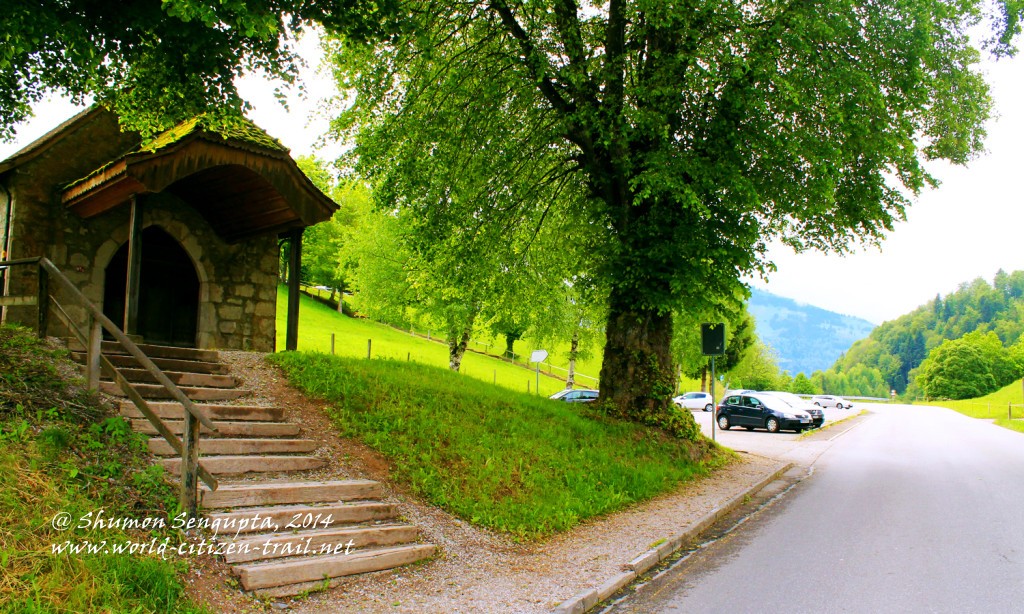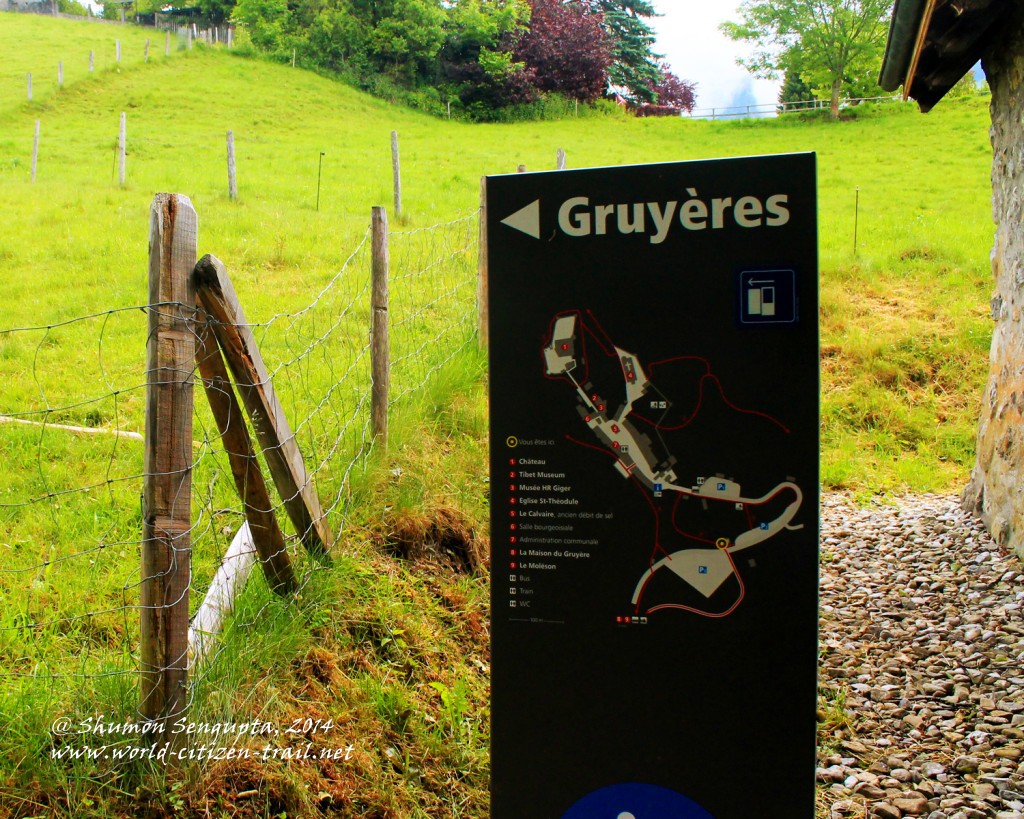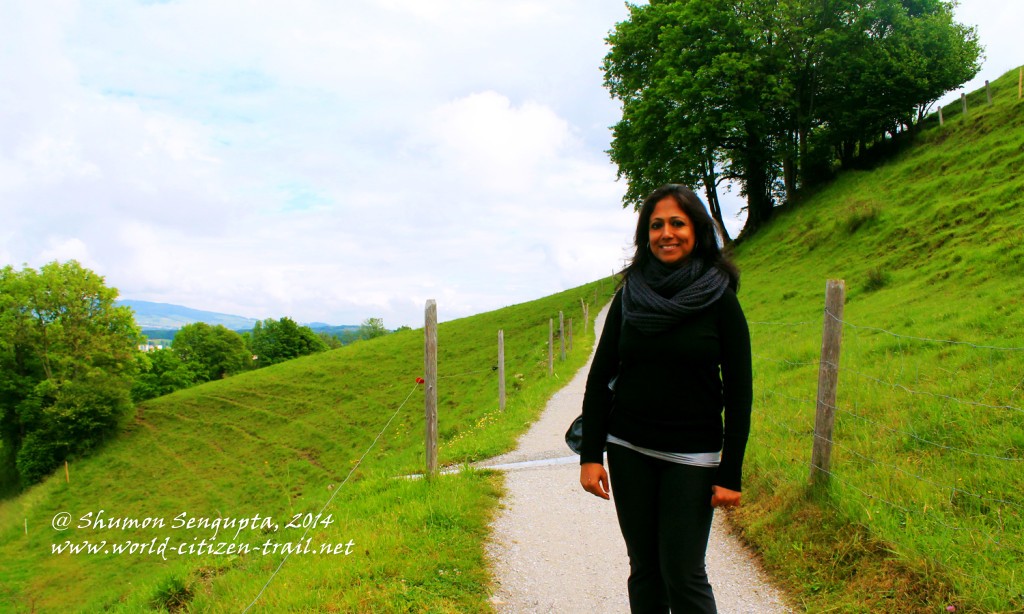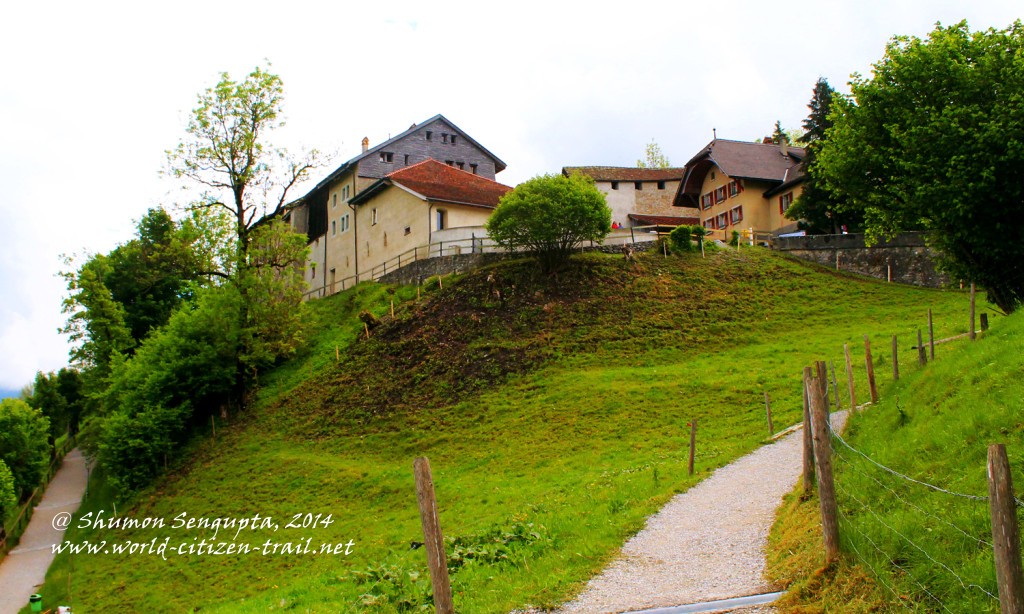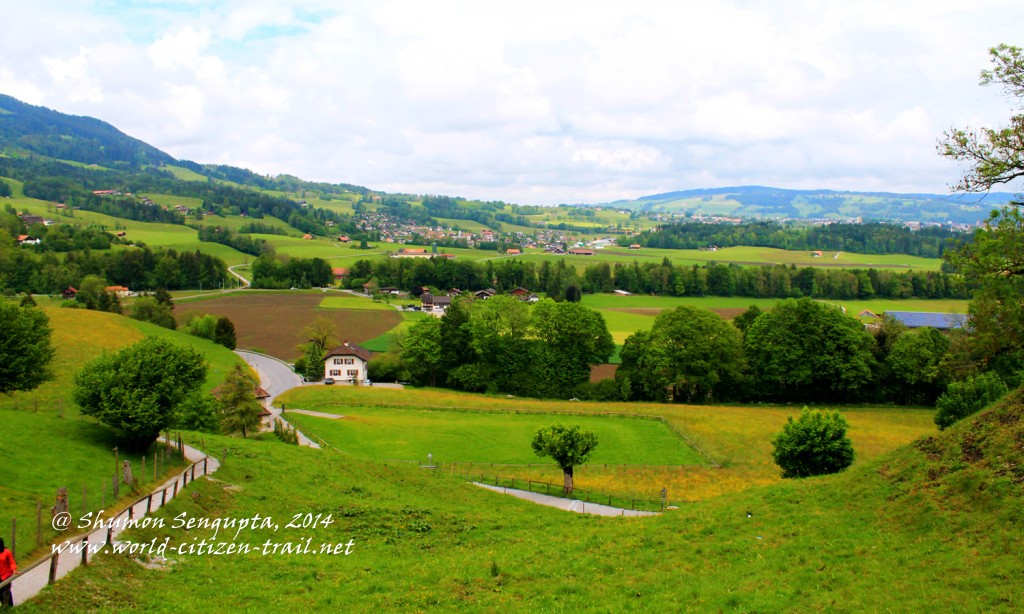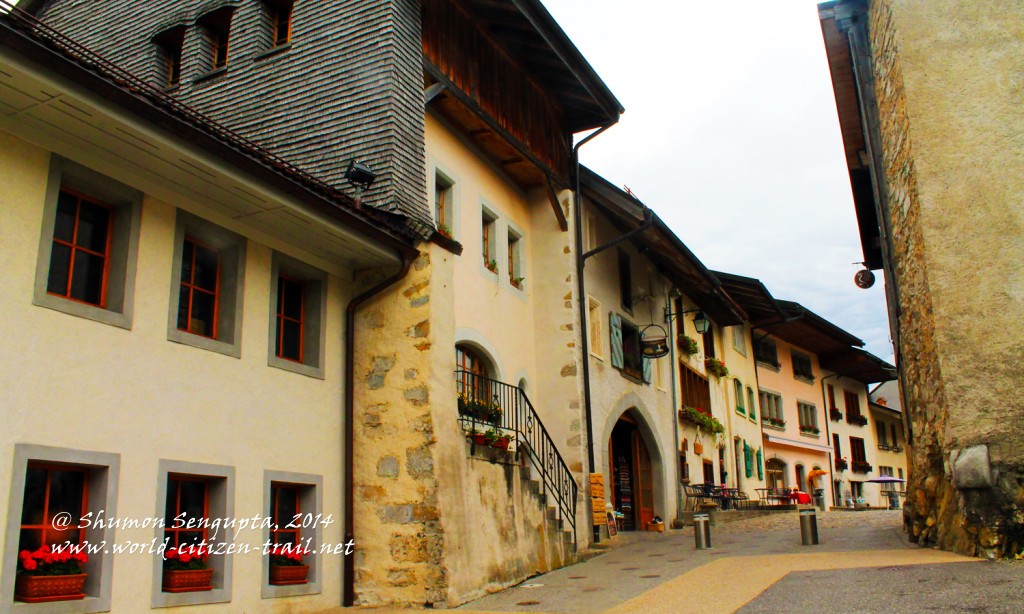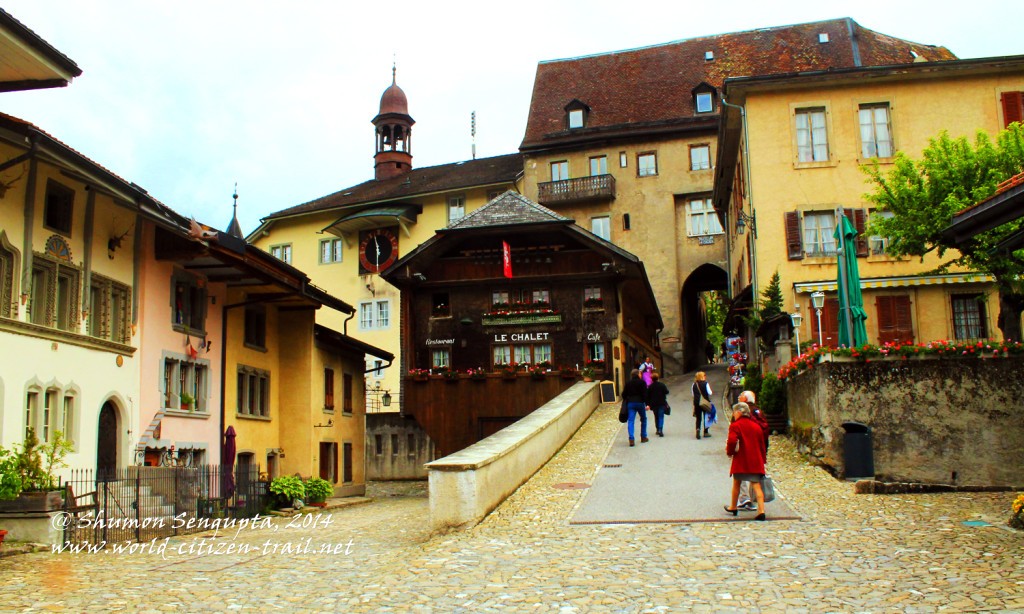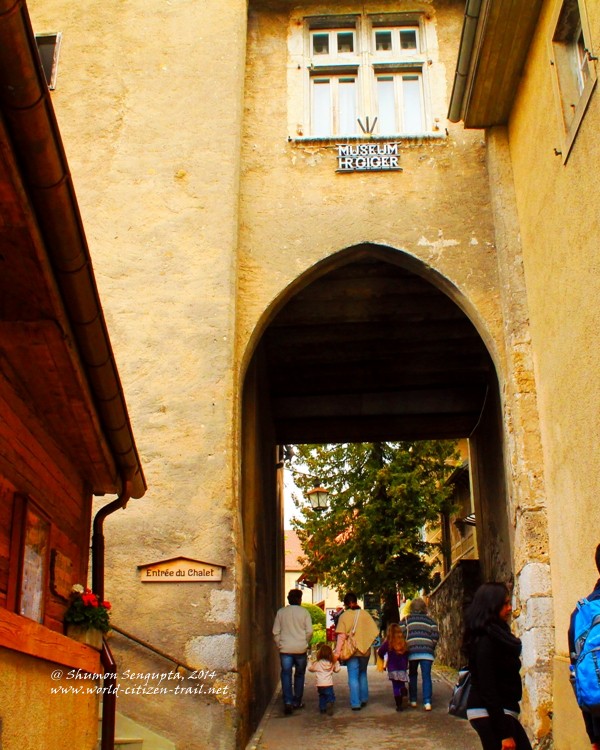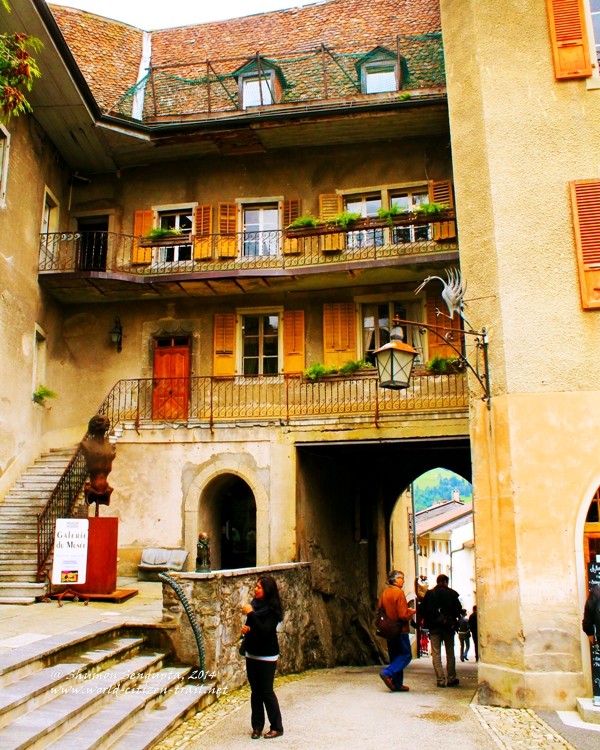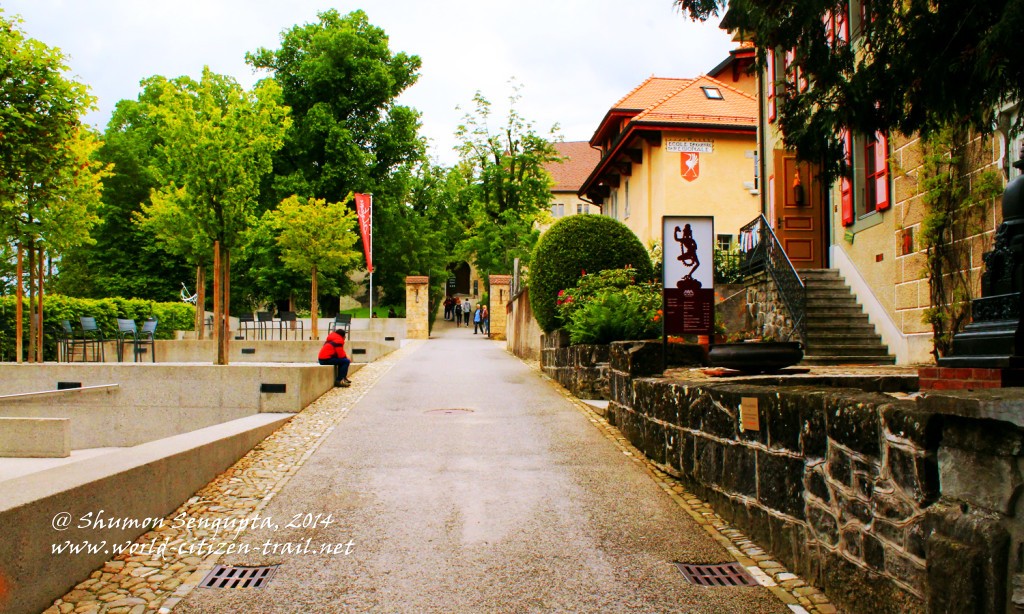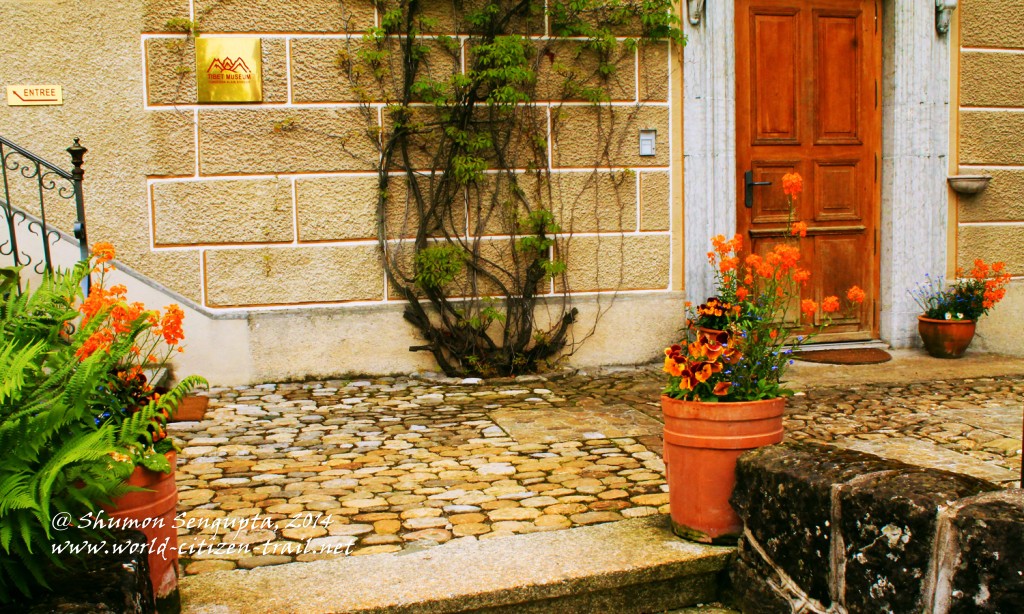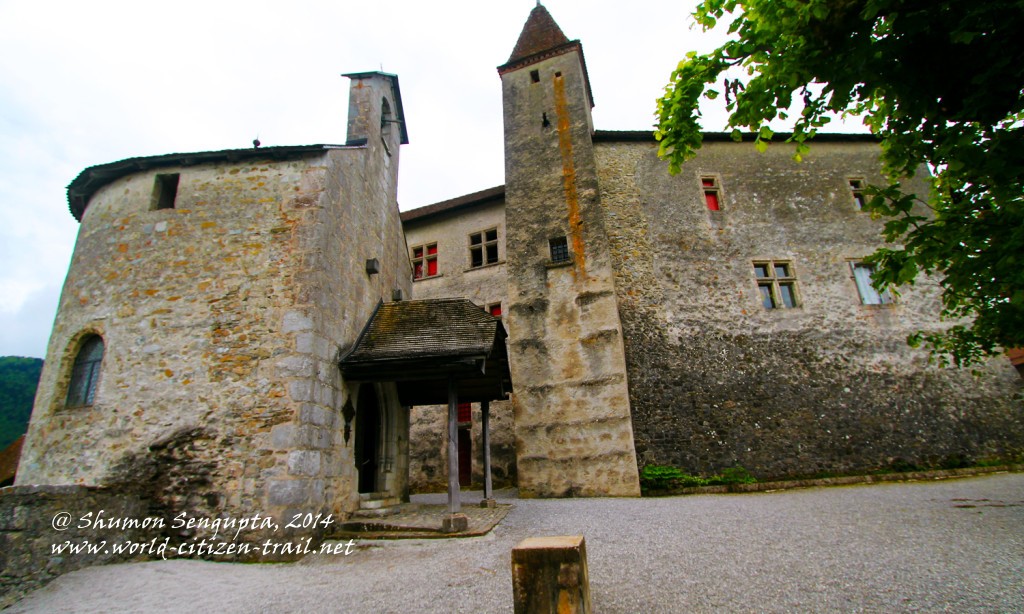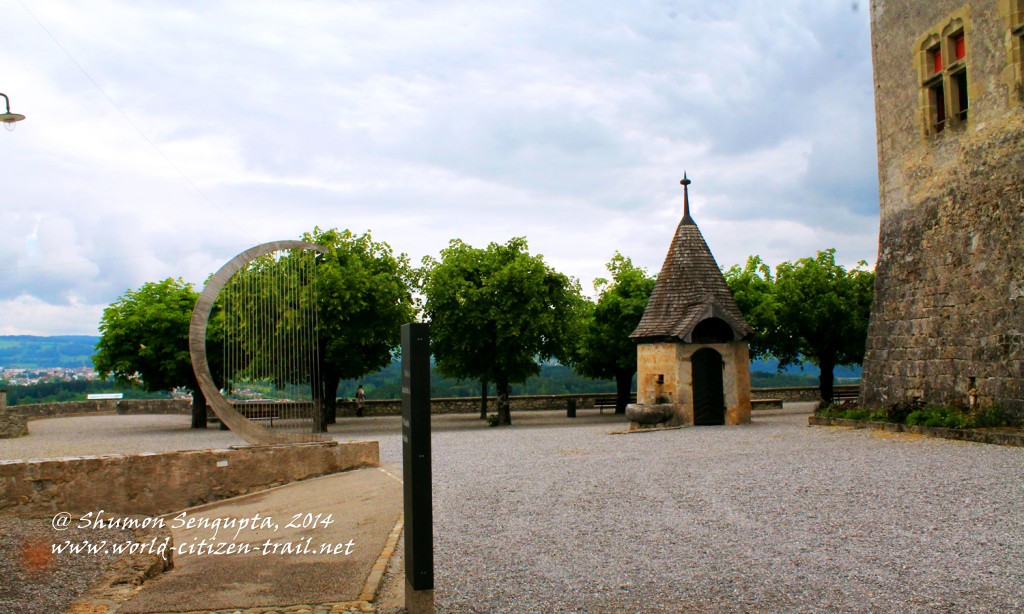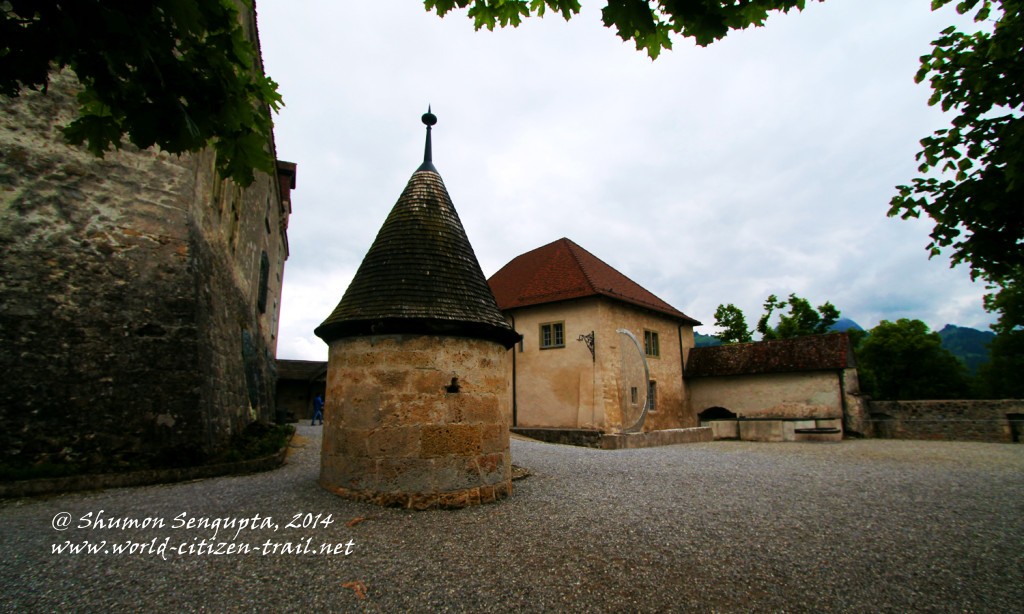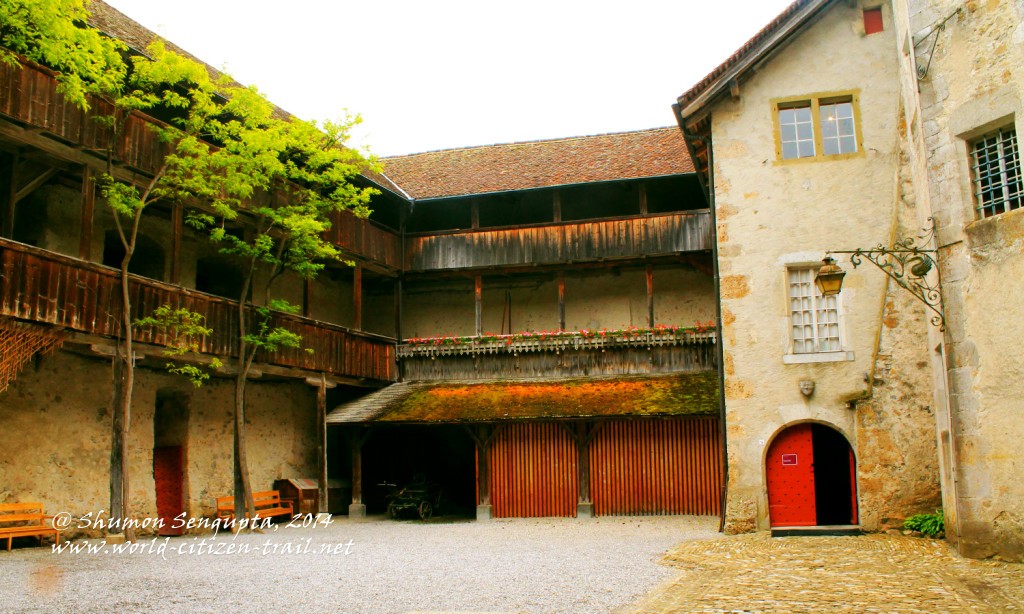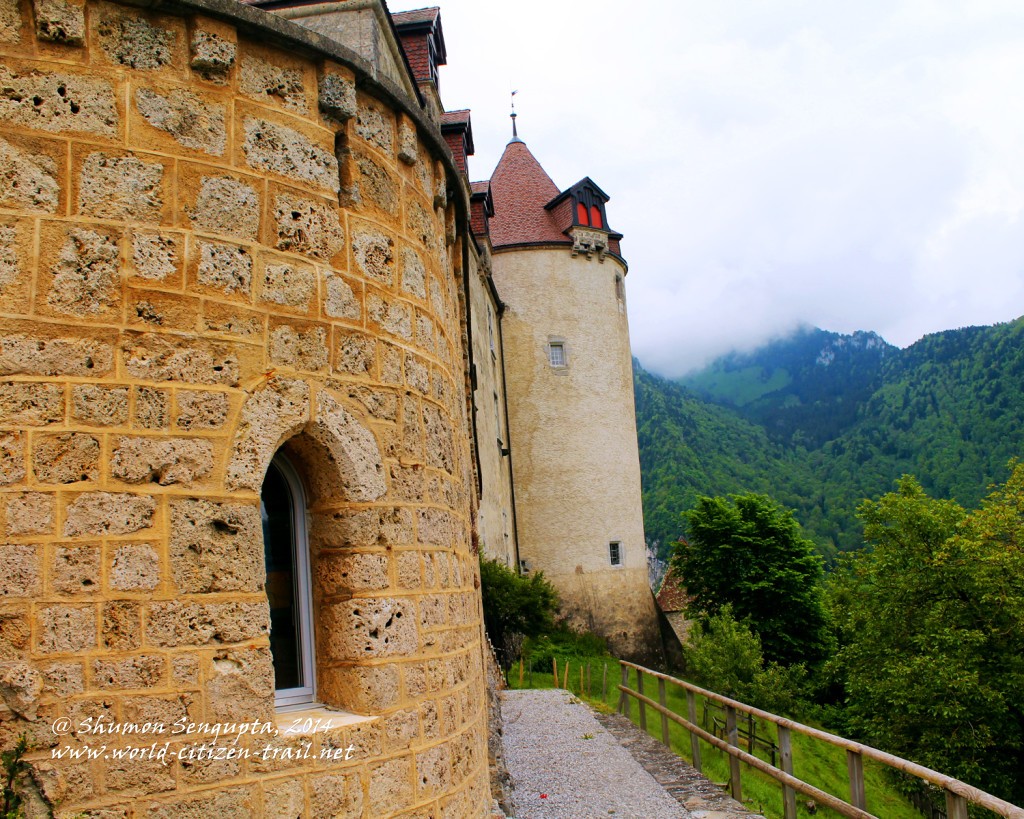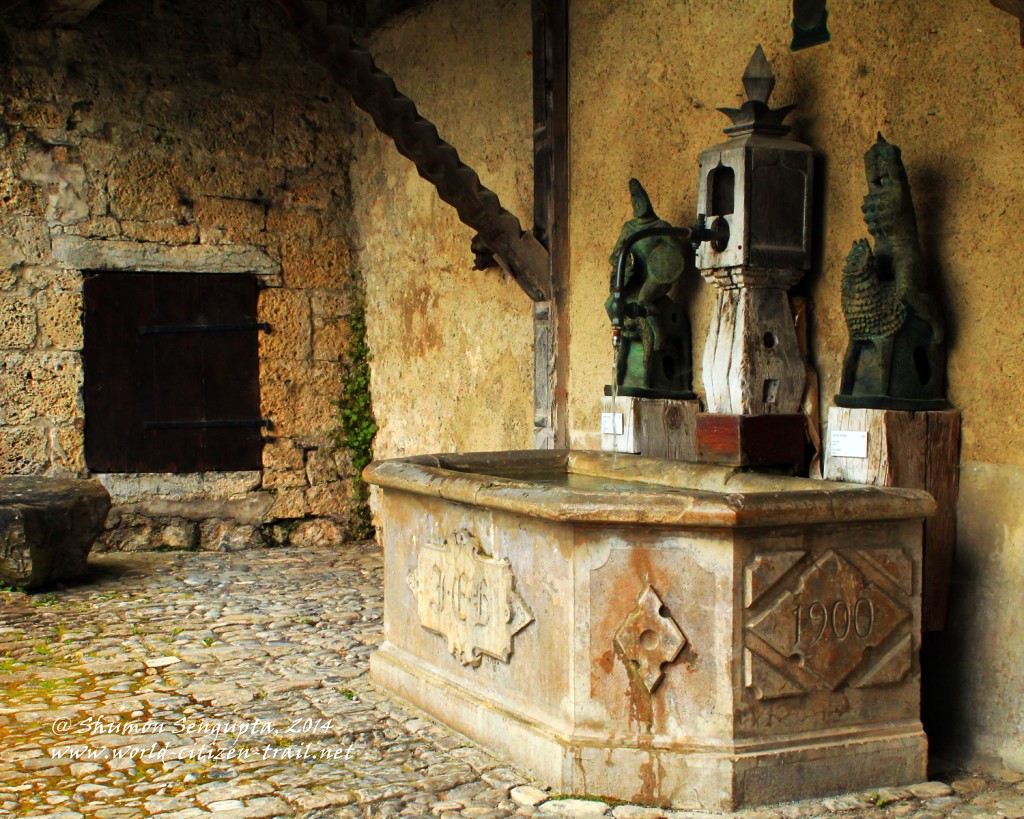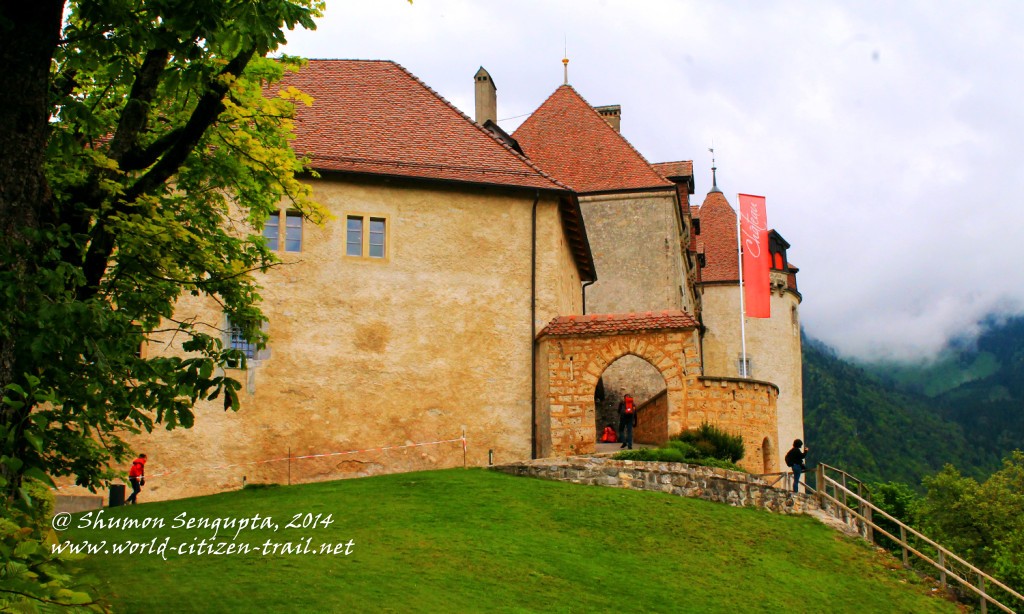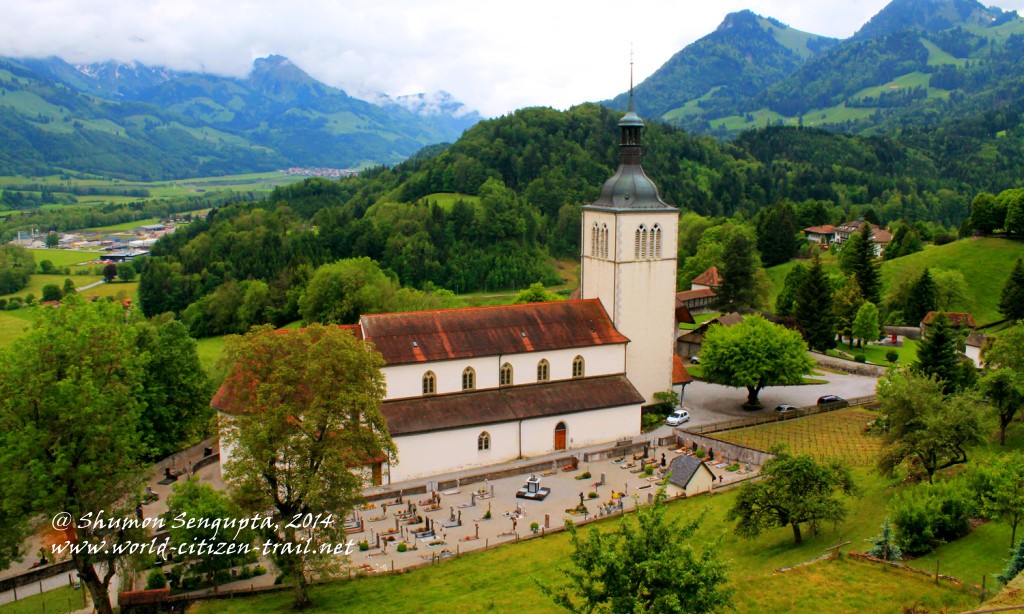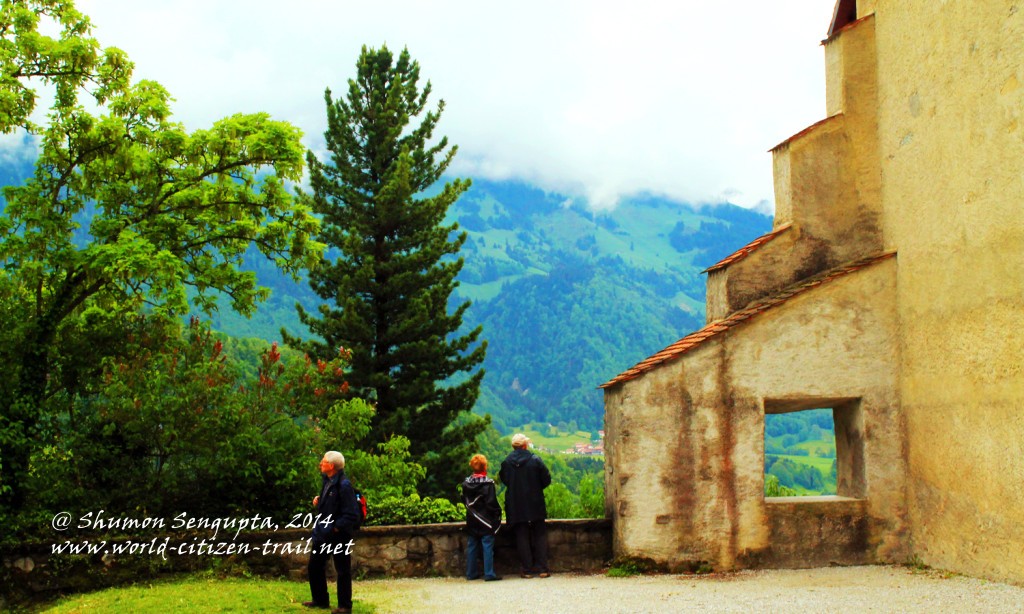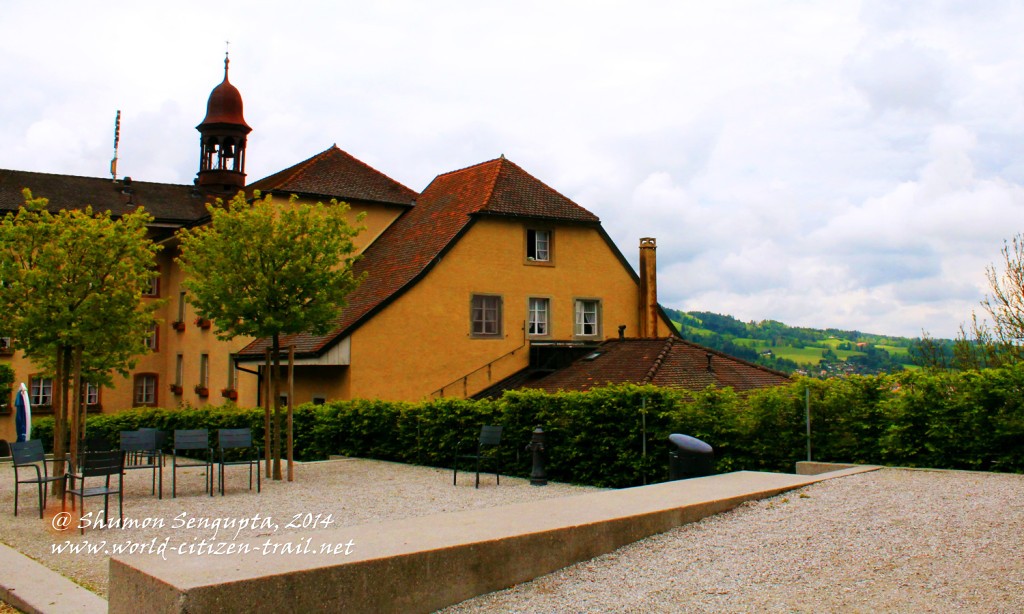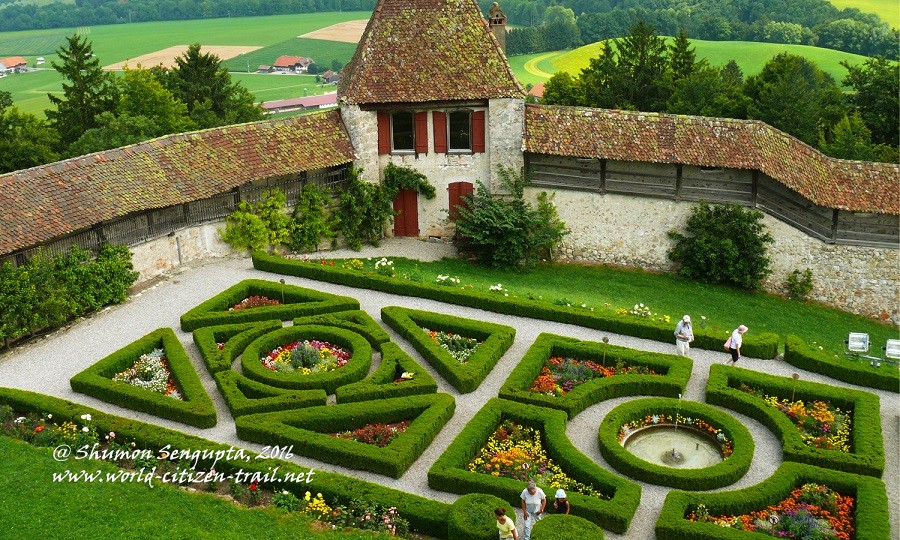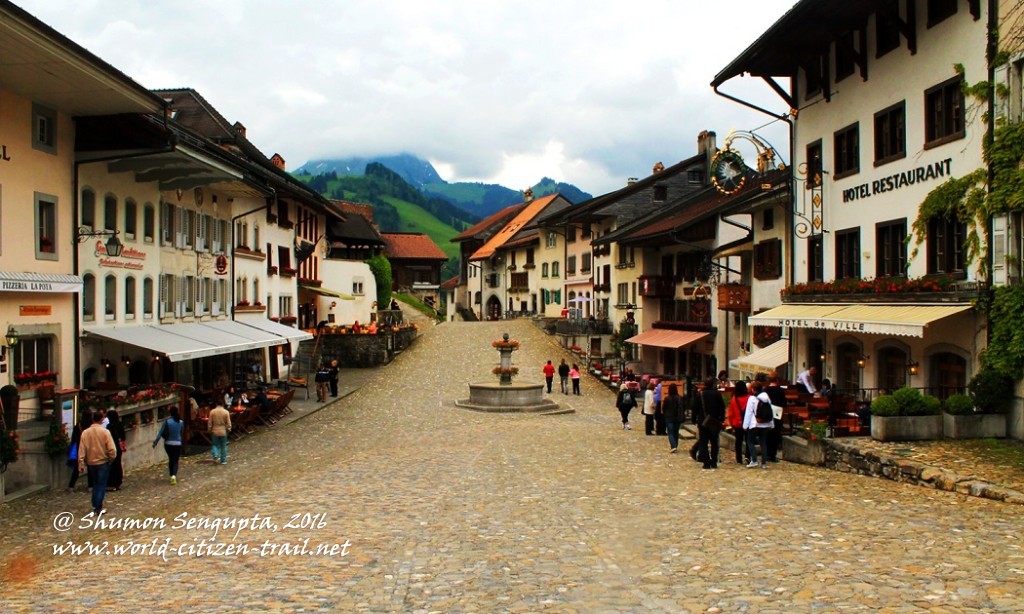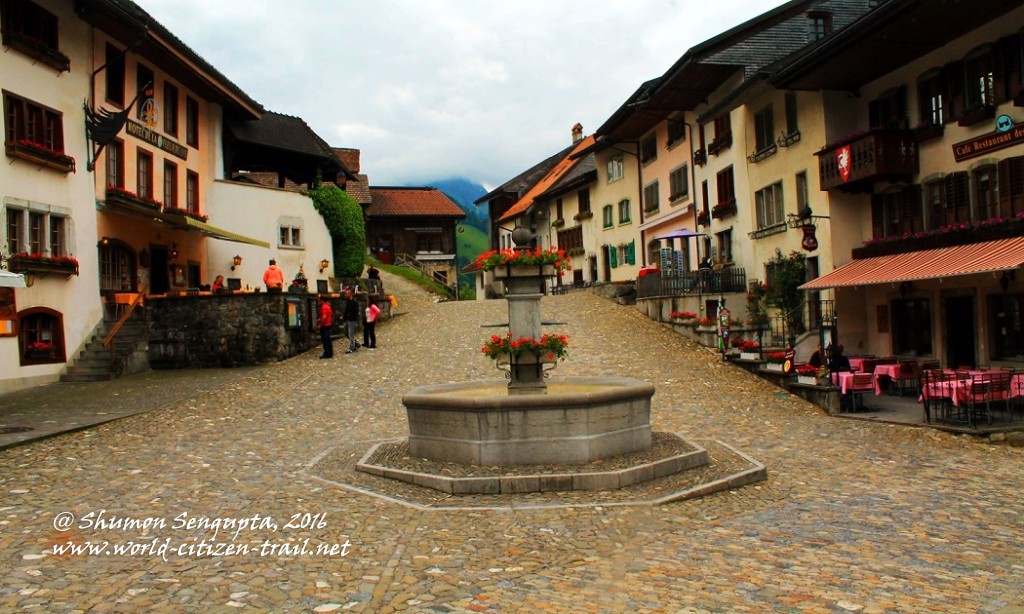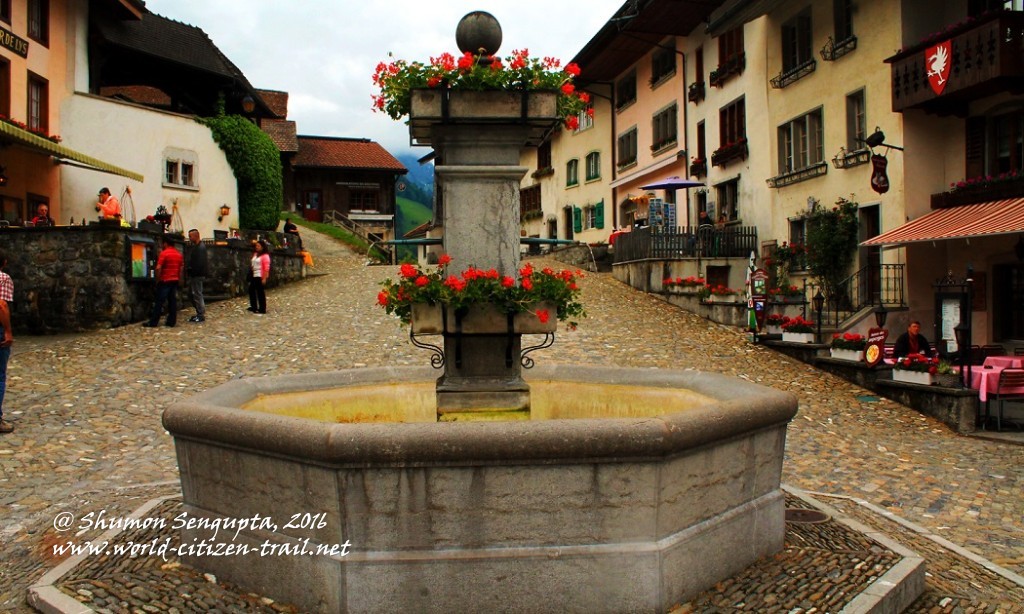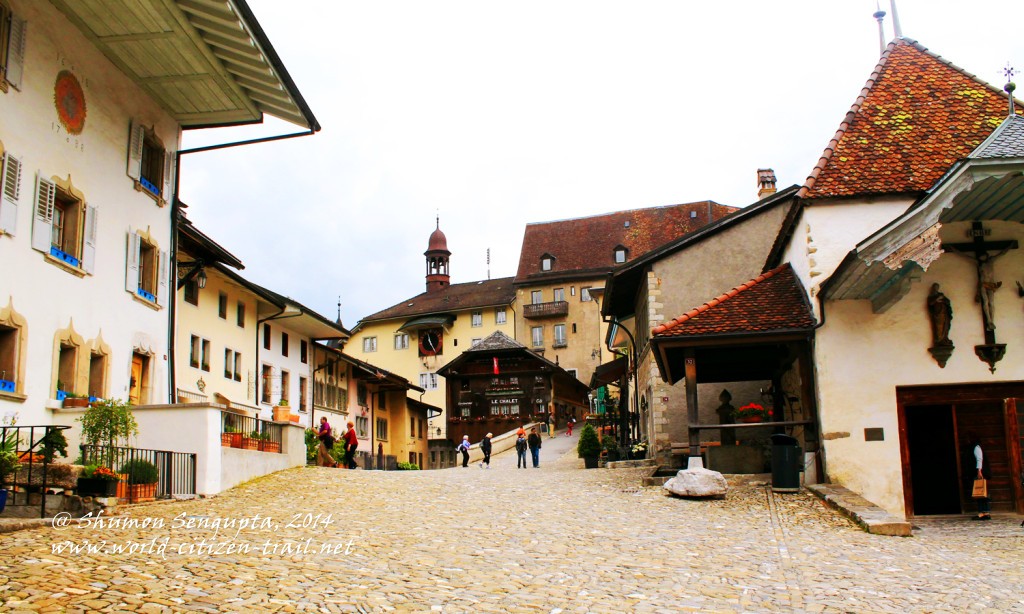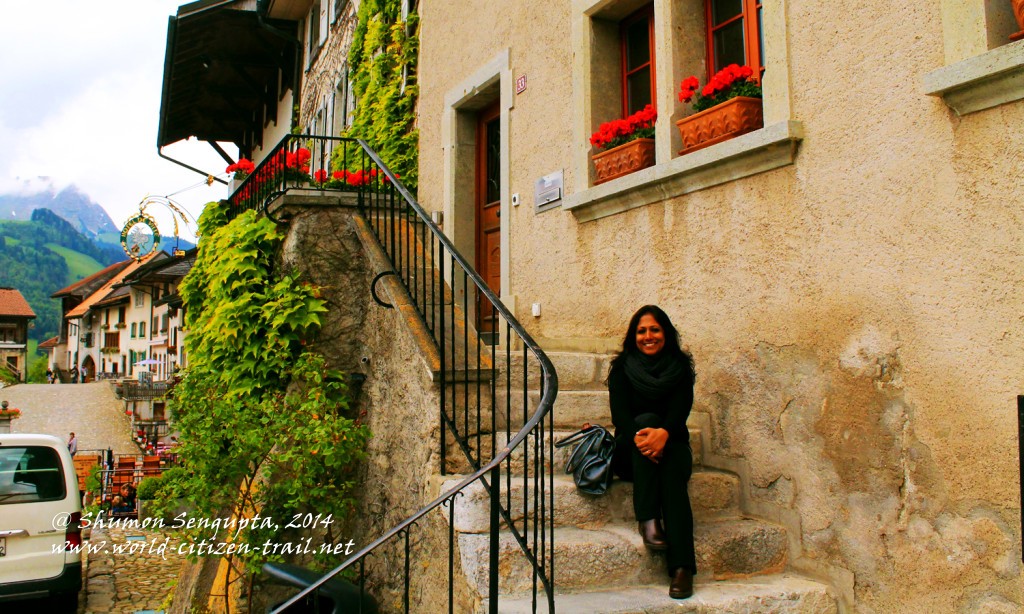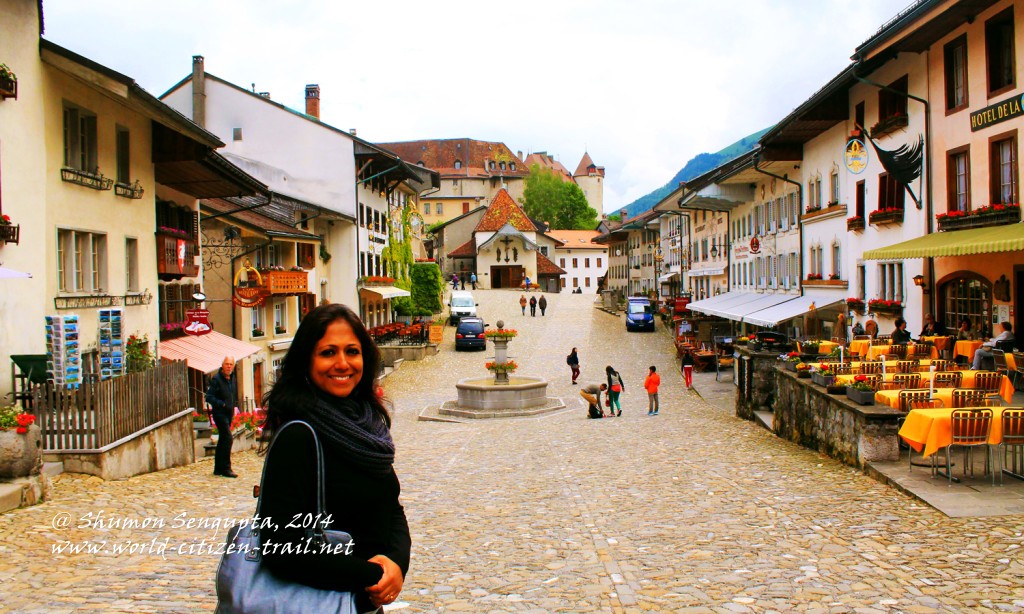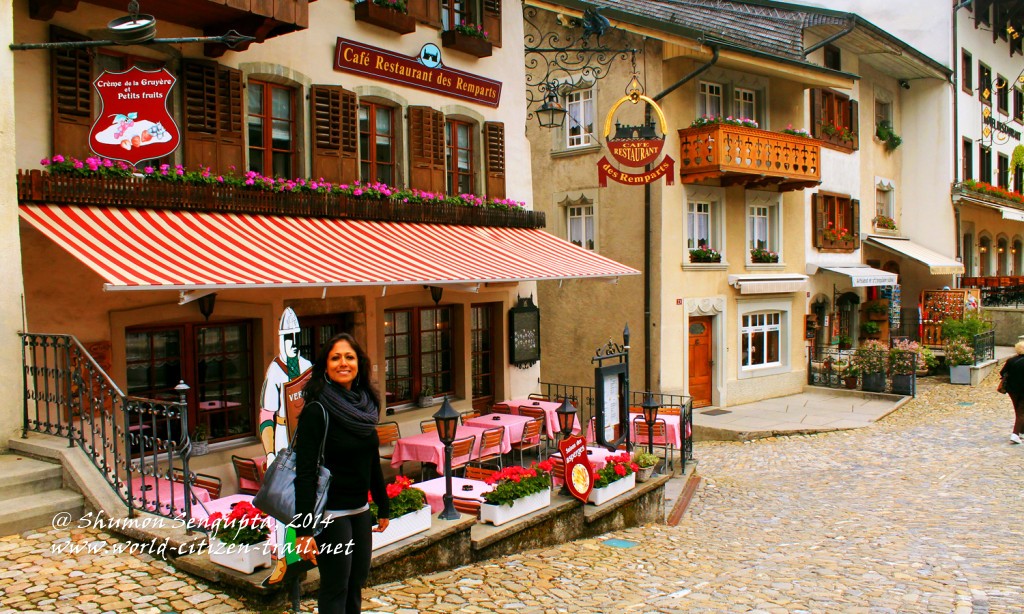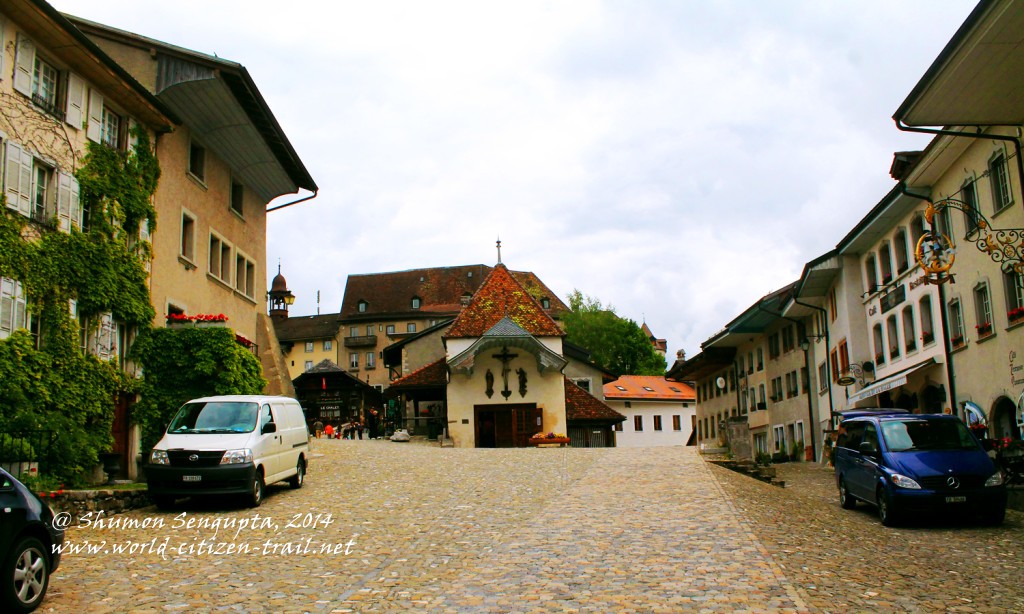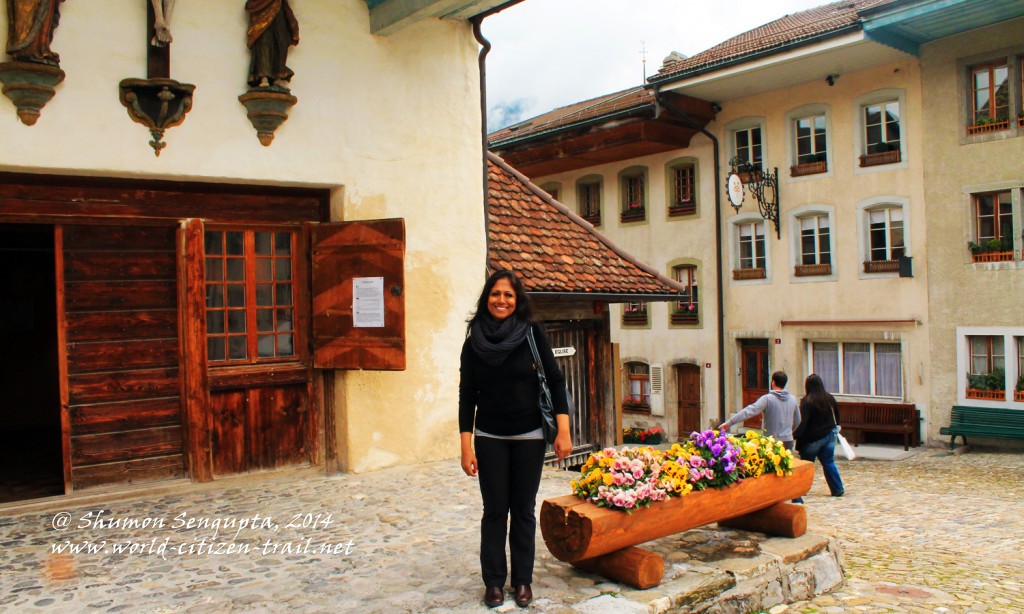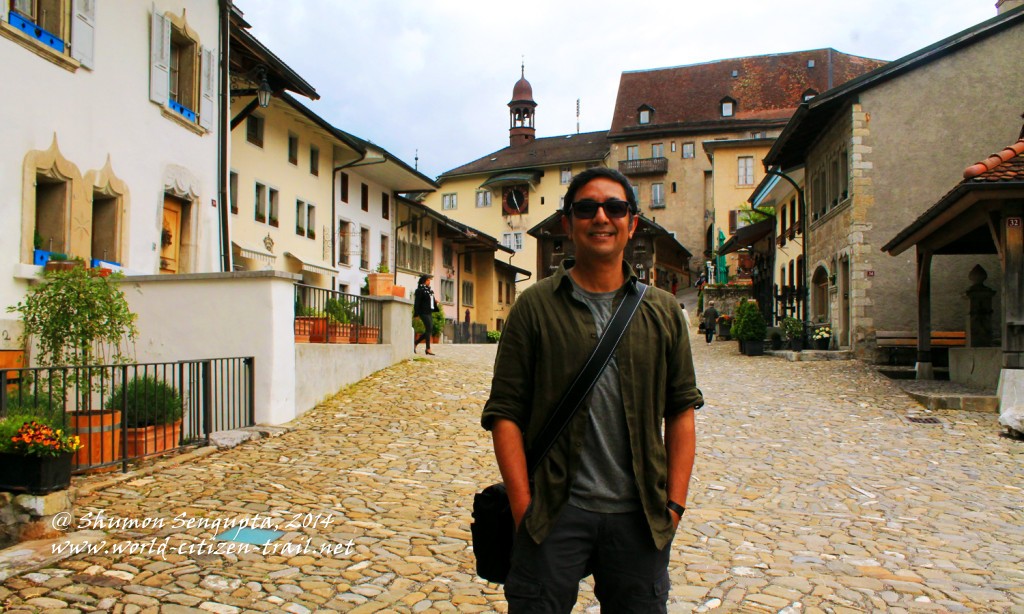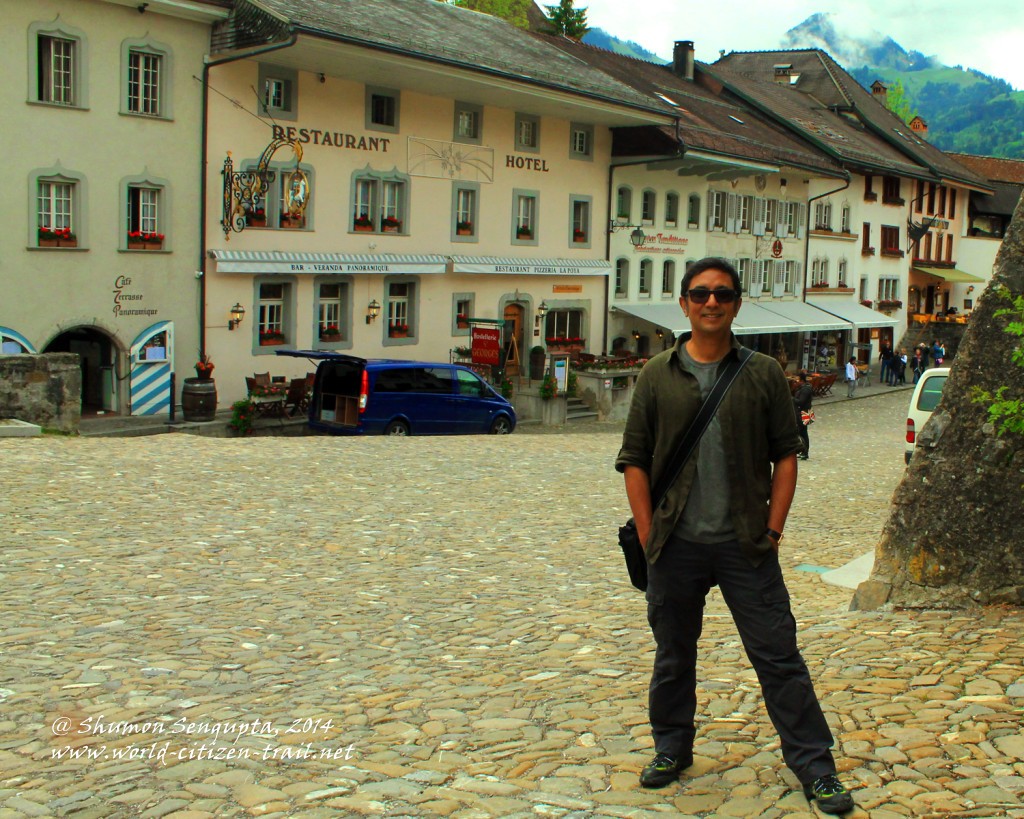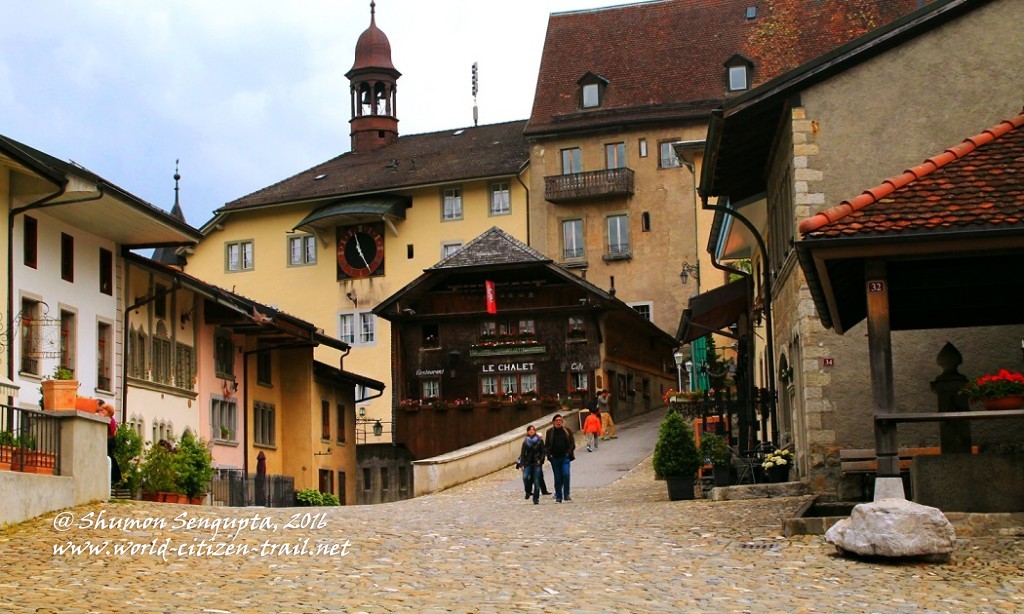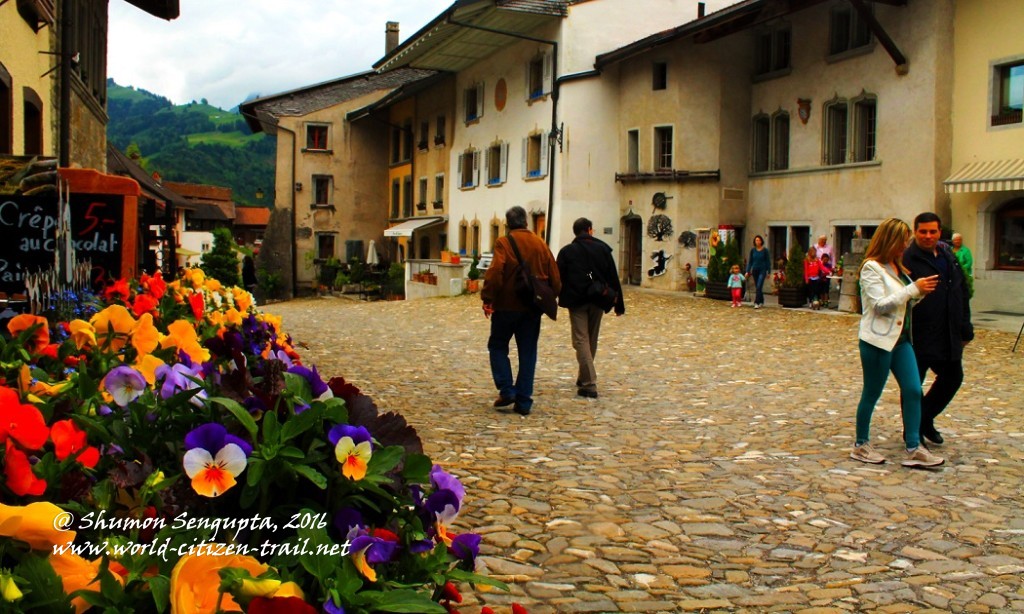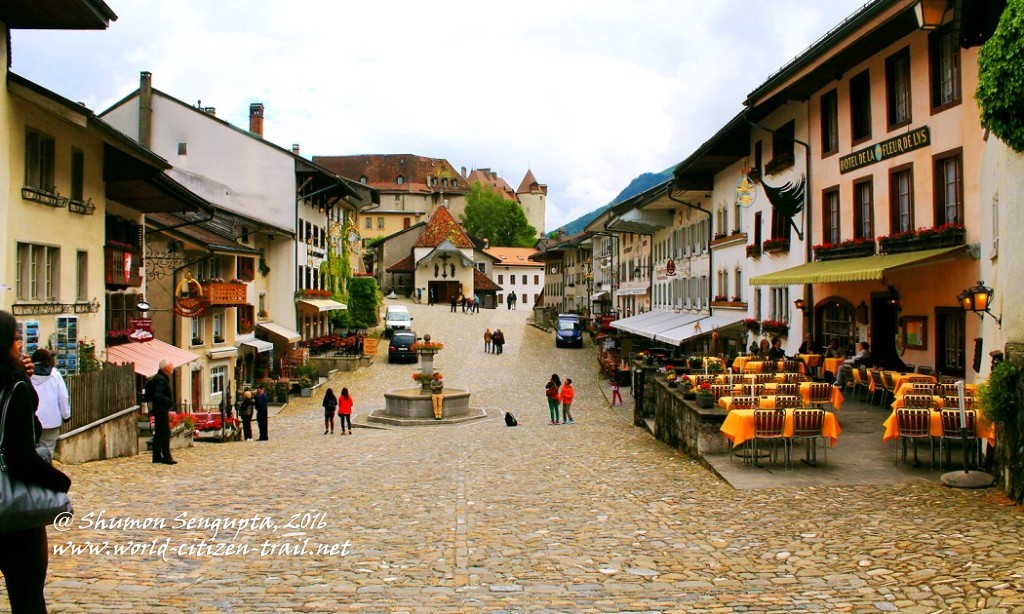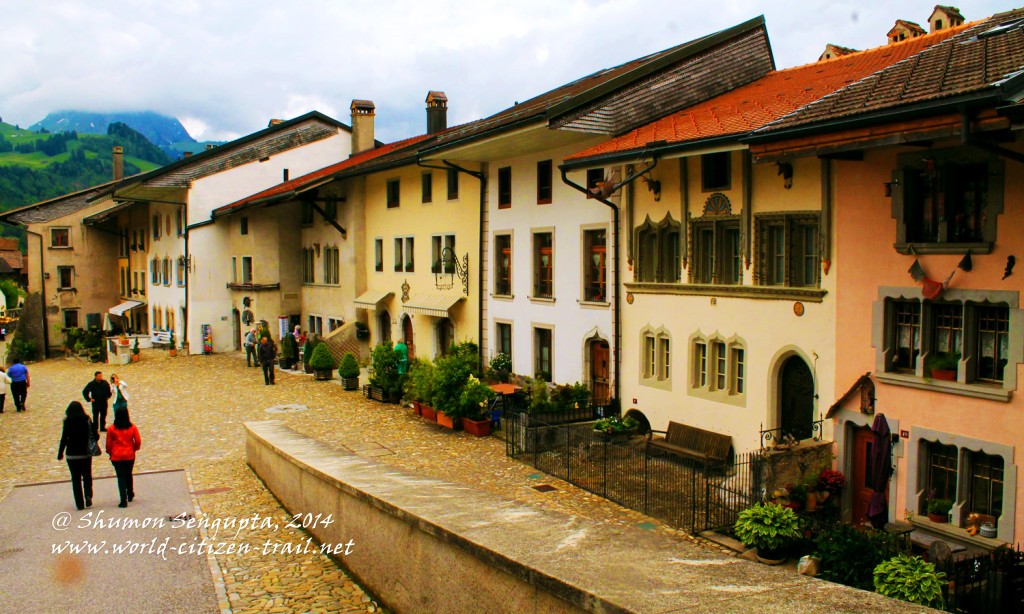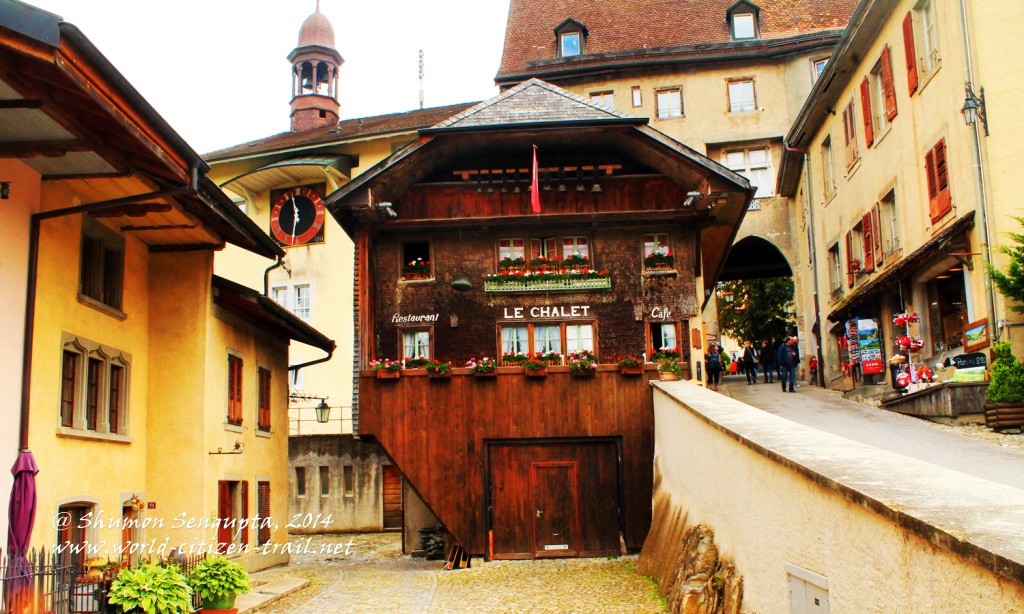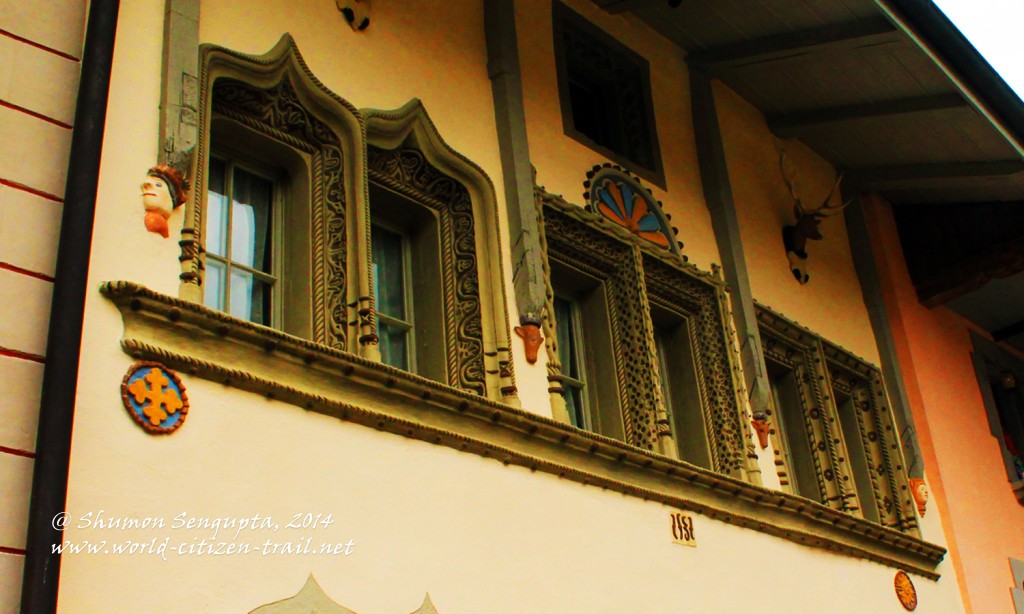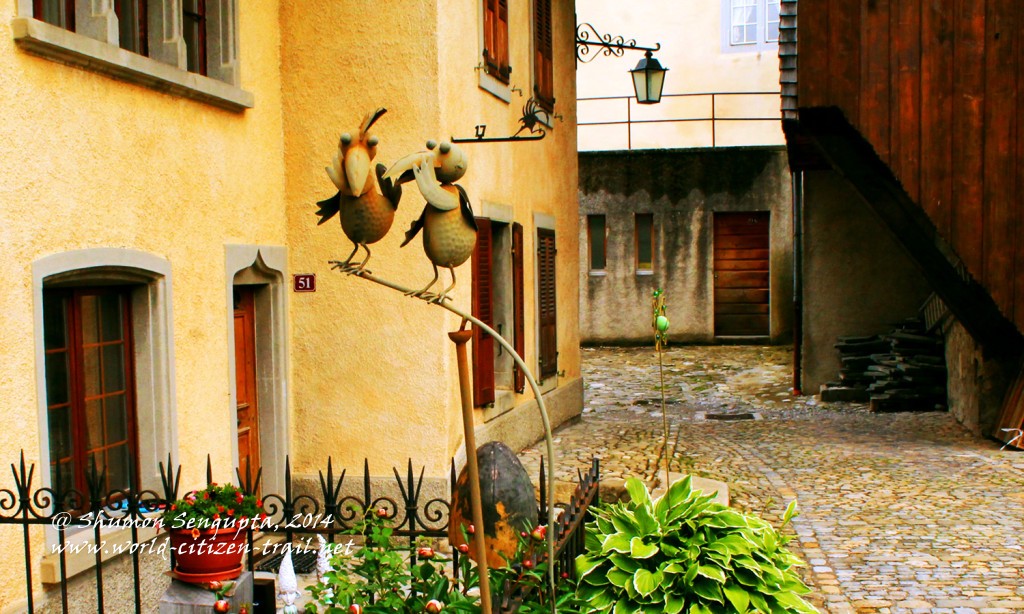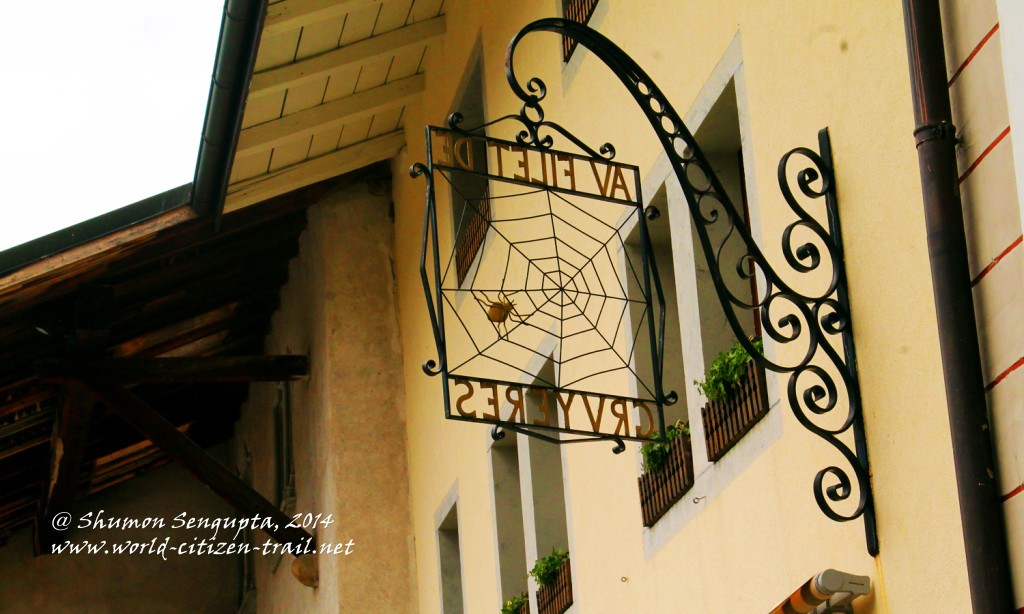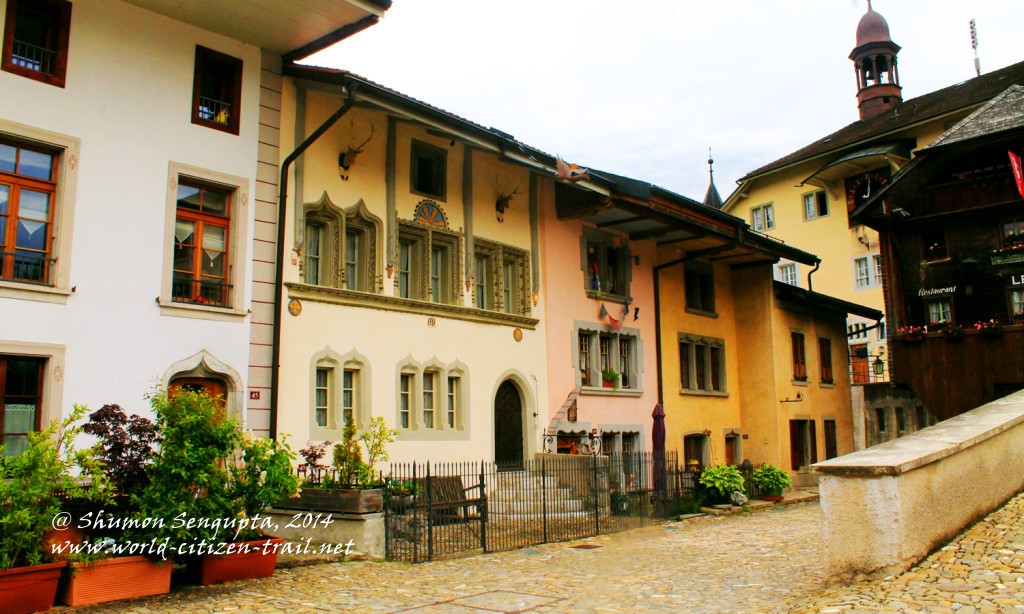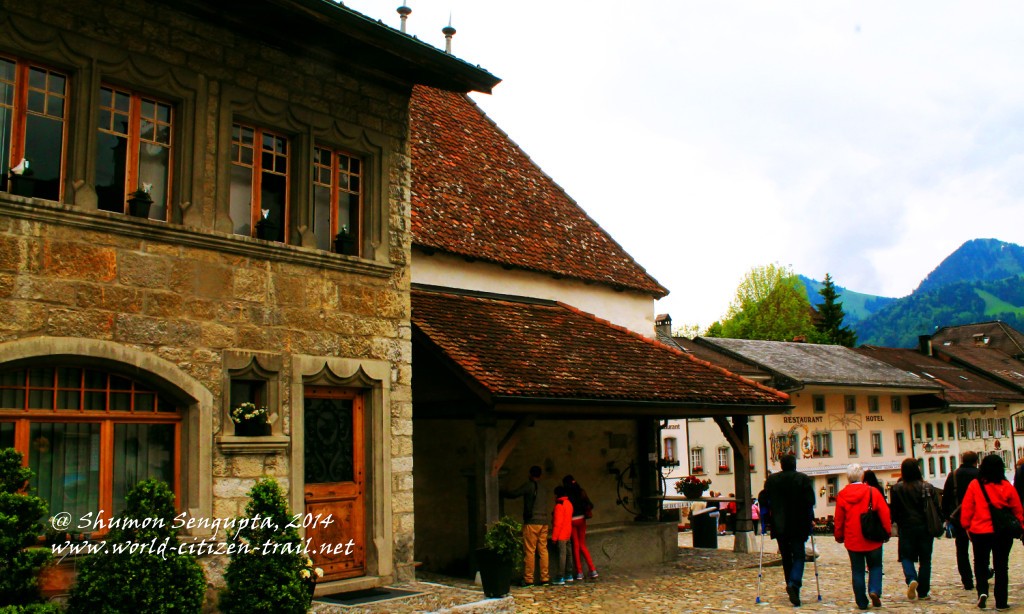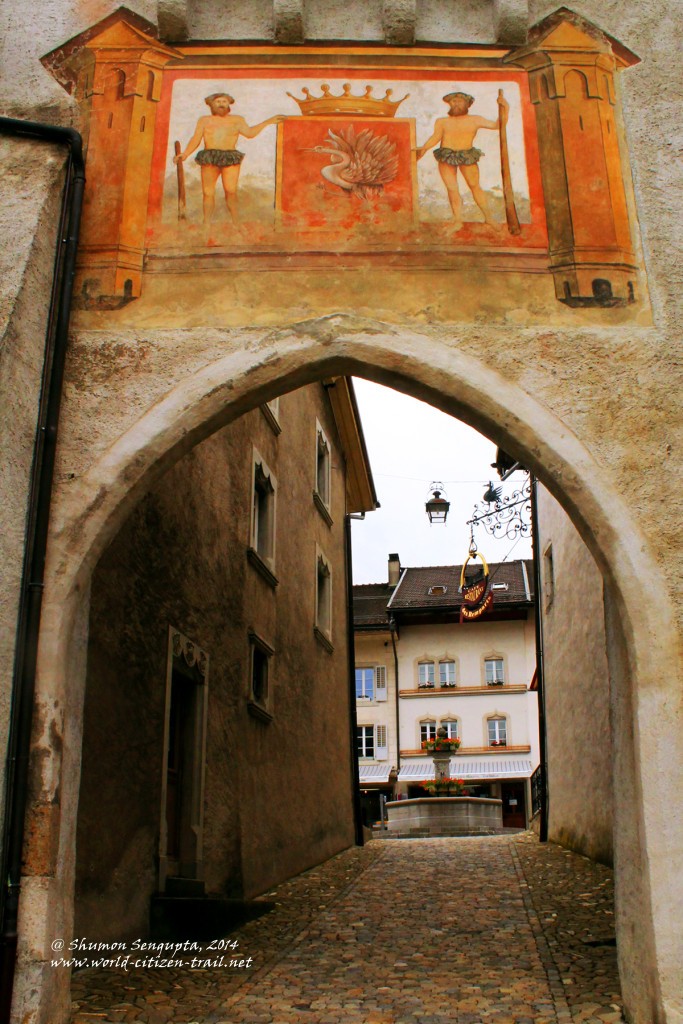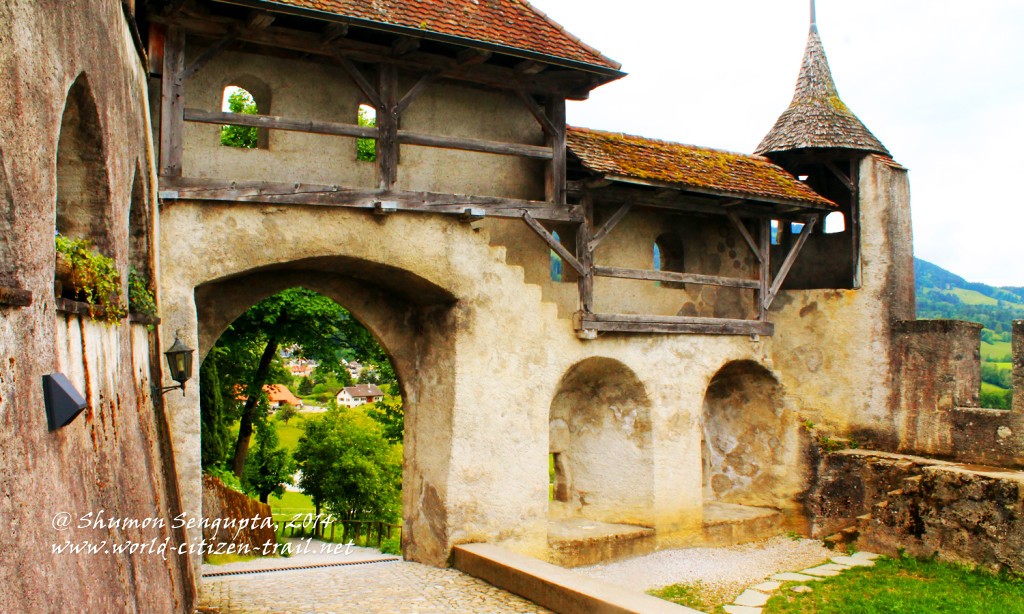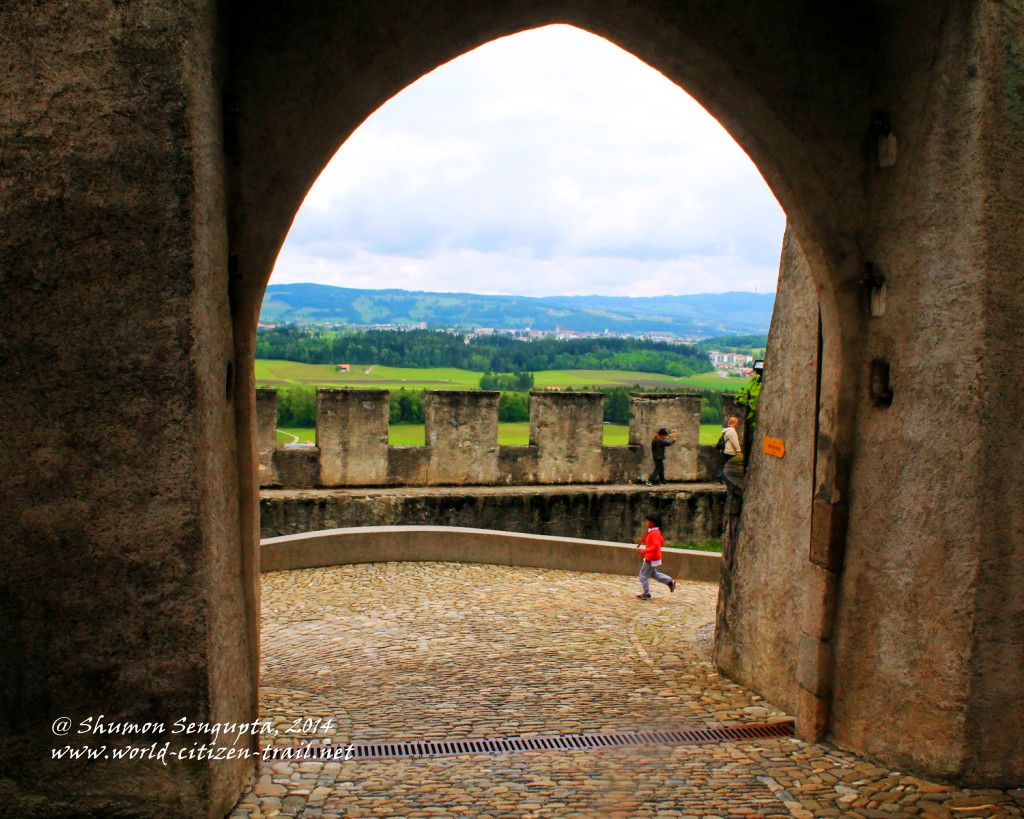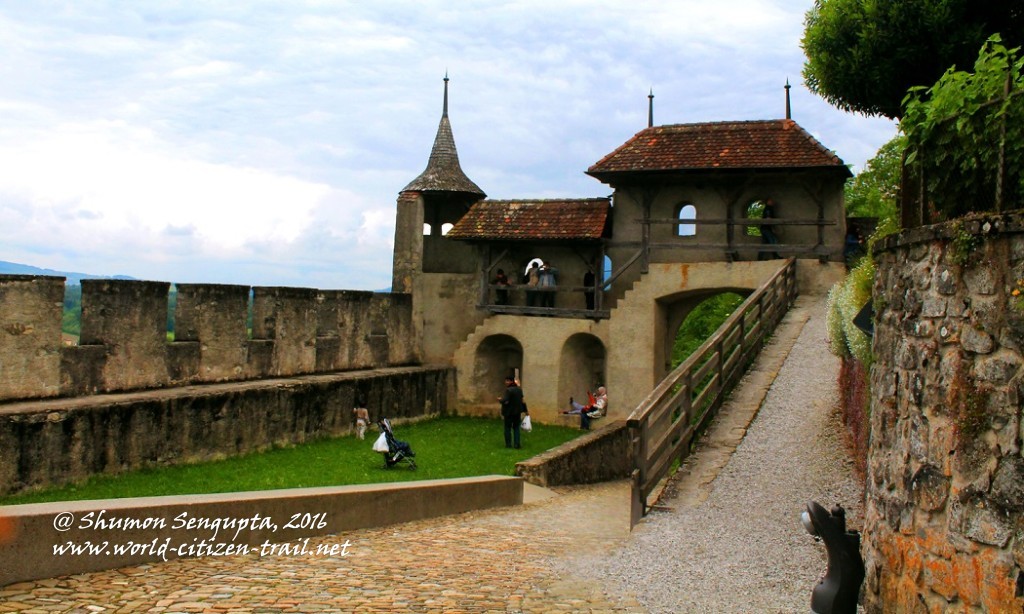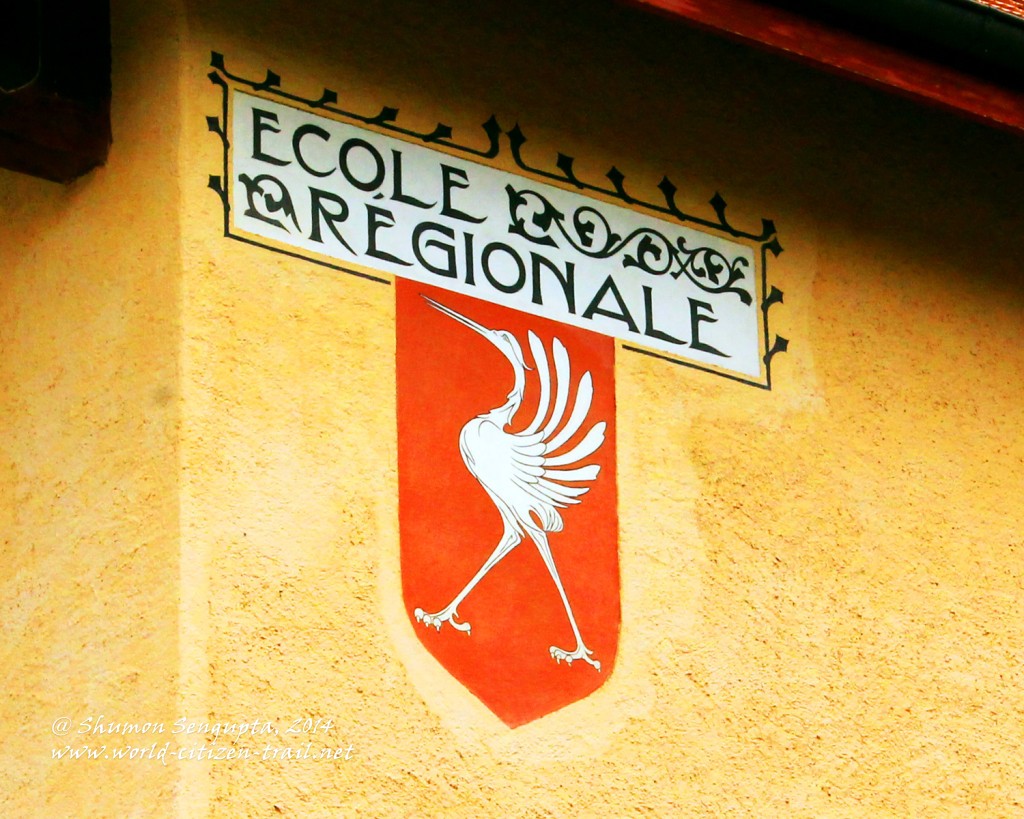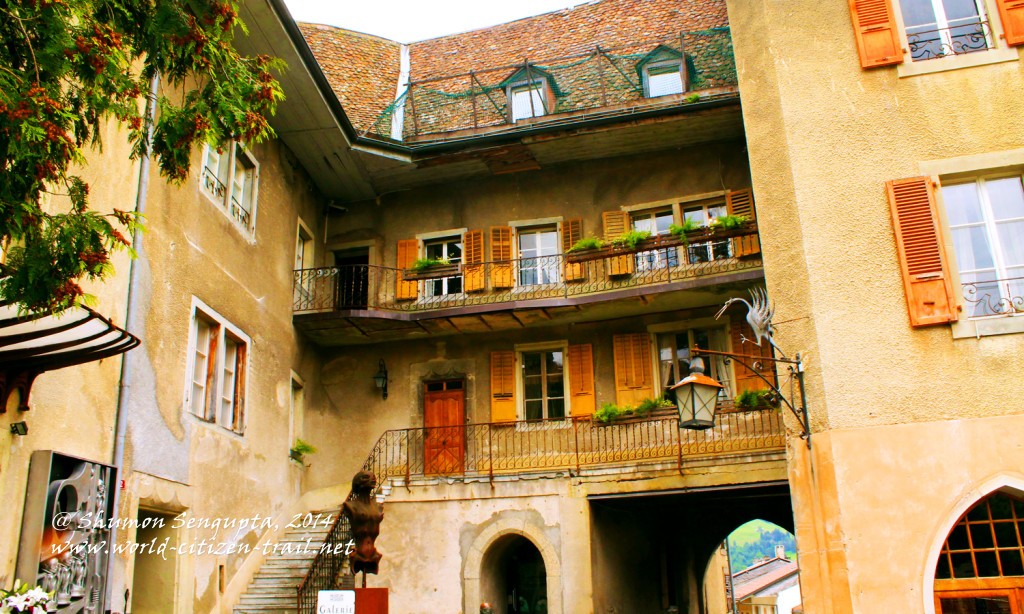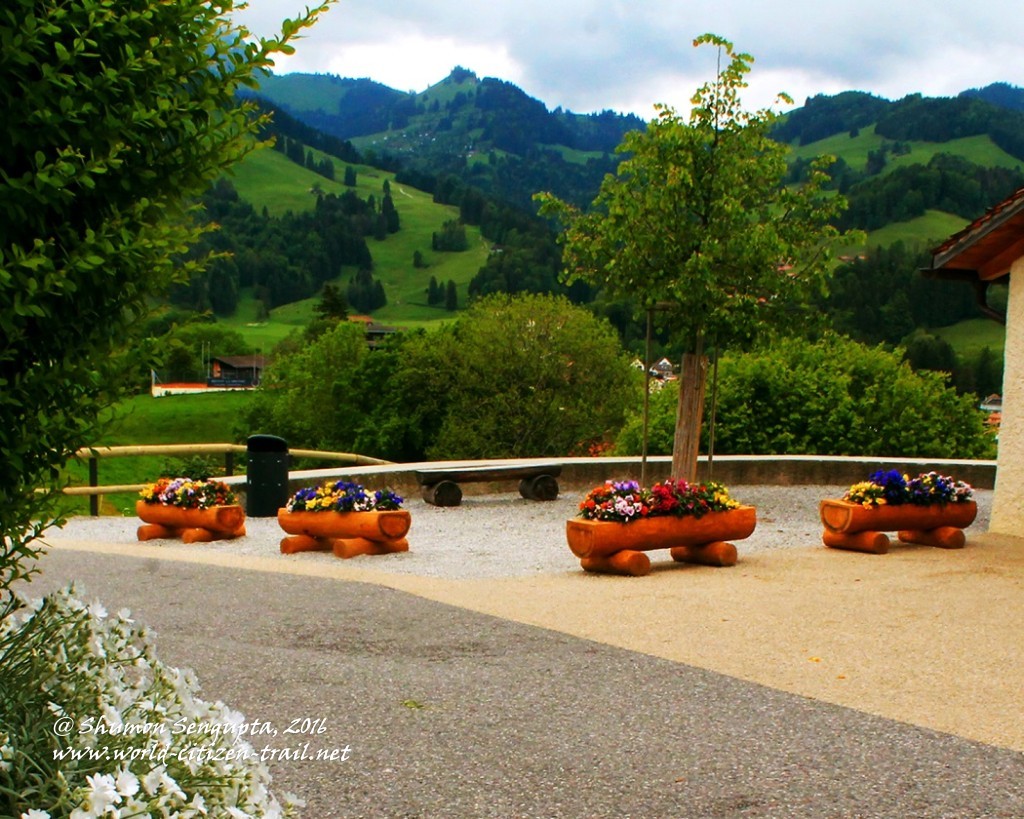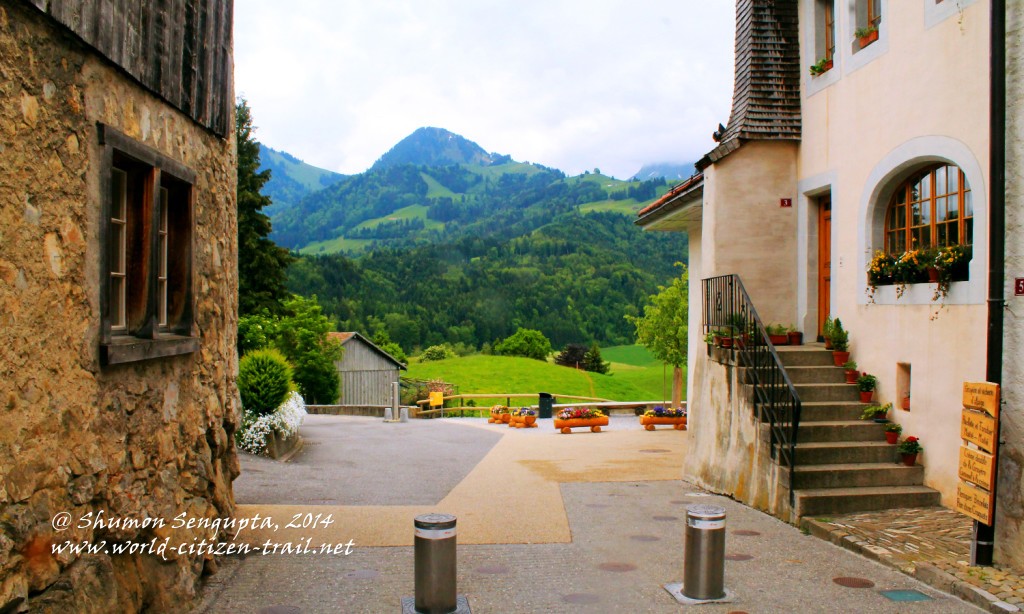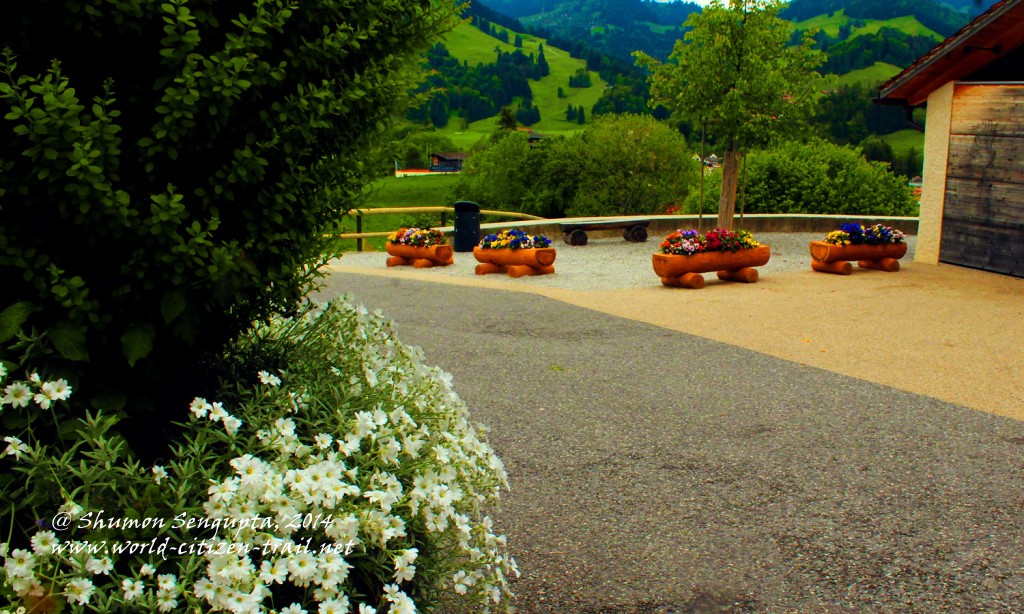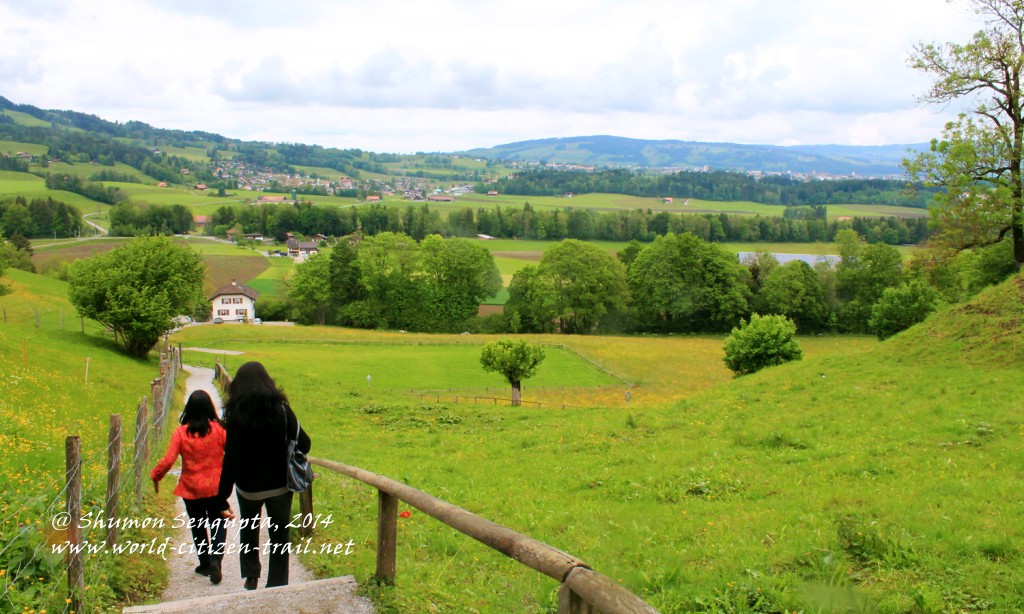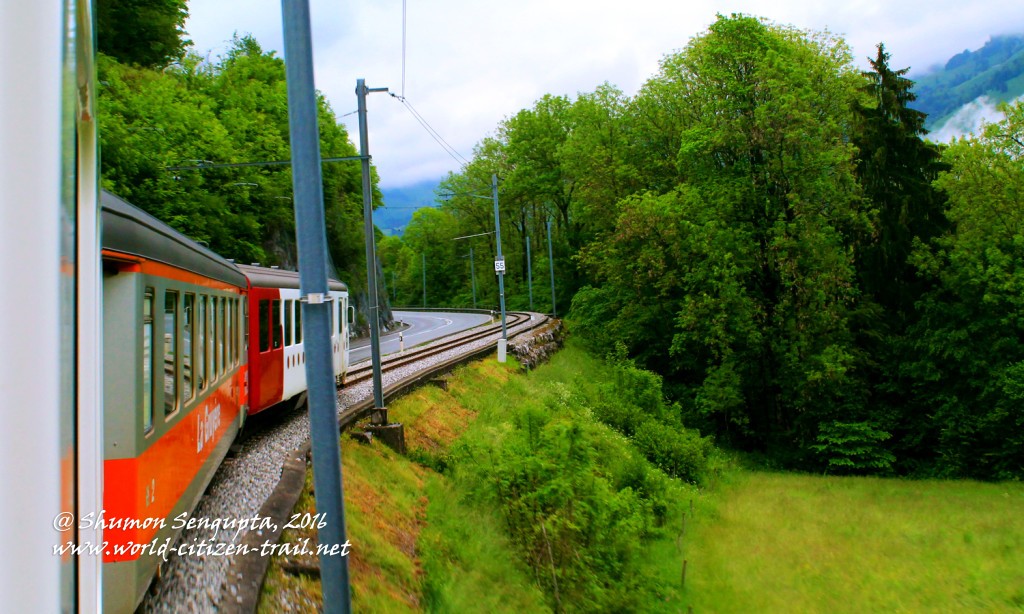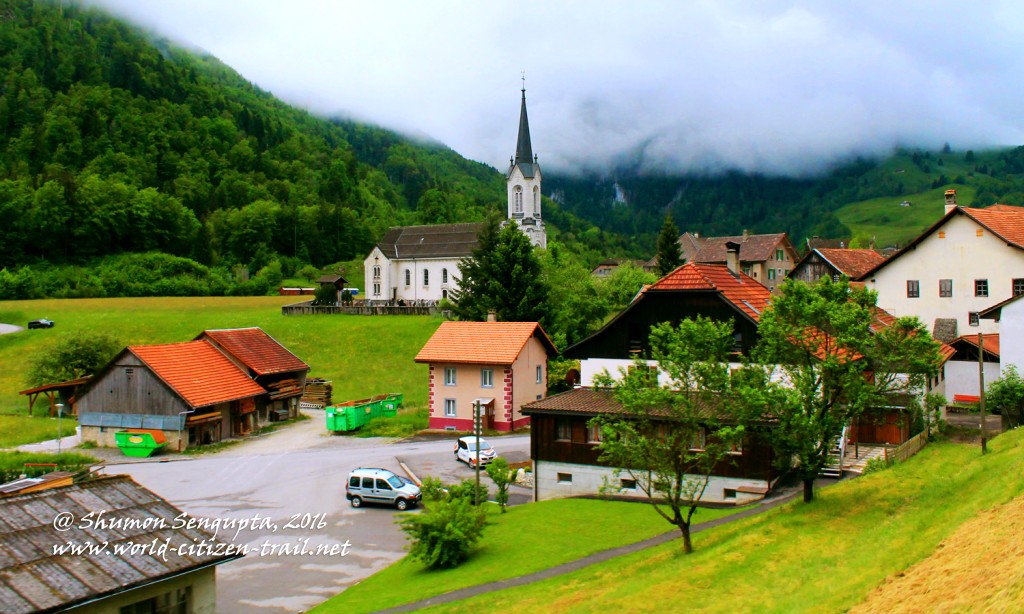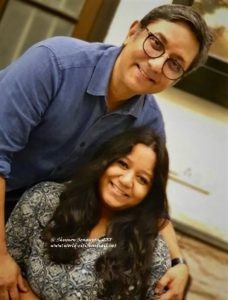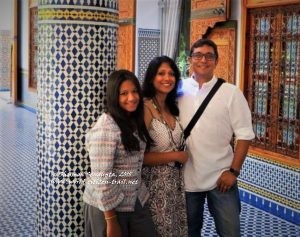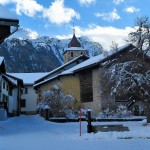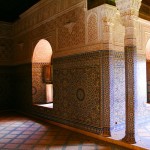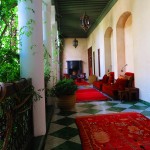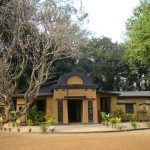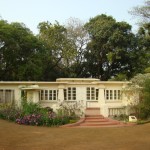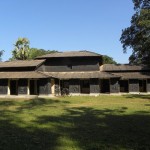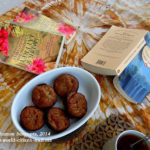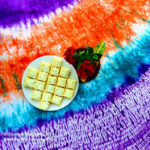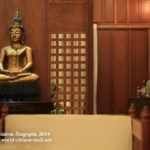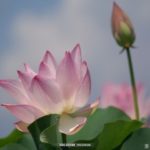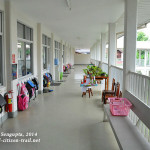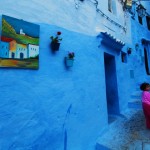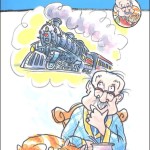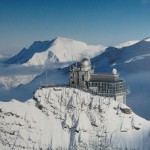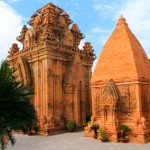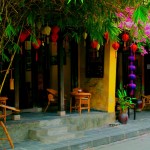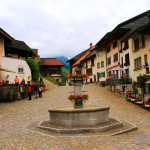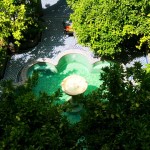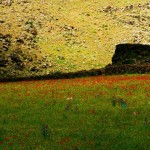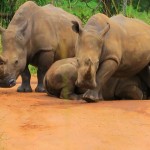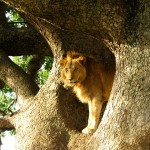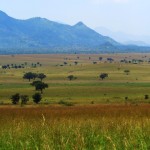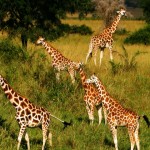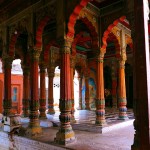The medieval village of Gruyères is perched on top of a hill, nestled by the lush green pre-alpine foothills of the Fribourg region of Switzerland. Overlooking the Sanne valley, it is an idyllic location of incredible charm and beauty.
The word Gruyères often conjures images of cheese, fondue, and double cream served with meringue or berries. But then there is more to Gruyères than that, as we discovered from our trip to this enchanting little village, during our 24-trip of Switzerland.
From Zermatt, we arrived in the canton of Fribourg by train, late in the afternoon. We stayed overnight at the Hostellerie Le Castel, next to the little railway station in the village of Le Pâquier, a few kilometers from the village of Gruyères.
From Le Pâquier, it was a 3 minute train ride to the tiny Gruyères railway station, located at the base of the hill on which the village is located. We made it fairly early in the morning and our first destination was the cheese factory called La Maison du Gruyères, located next to the railway station.
Being a demonstration factory, audio tours on cheese-making are available for visitors. We took the audio tour and observed the process of making cheese from the visitors’ gallery/observation deck located above the main floor, separated by a glass wall.
Huge amounts of fresh milk arrive from nearby areas into the factory and go into making over forty rounds of cheese every day. Cheese is made using the traditional process followed in this area and Gruyères cheese is a designated AOC product, which specifies the geographical area and the traditional method by which the cheese is produced. This essentially means that branded Gruyères cheese cannot be produced in any other area and through any other method than what is traditionally practiced in this place.
At this factory, we got to know quite a bit about the production of this particular variety of cheese and the inter-generational tradition of cheese making, as we observed the process from the glass enclosed observation deck. There is a fascinating section where one can smell the wide range of aromatic herbs that cows grazing in this area eat while grazing. Apparently, cheese experts can determine the herbs cows ate, by tasting the cheese!
At the ground floor level, next to the reception, we saw the cheese cellar through glass windows. There was an automated robotic machine moving along the aisle in between long rows of cheese wheels, brushing, flipping and repositioning the cheese wheels periodically, as a part of the aging process of the cheese.
And included in the entry ticked was a sample of three kinds of Gruyères cheese – fresh, mild and ripe. There is a restaurant and souvenir shop next the reception of the factory.
After visiting the cheese factory, we hiked our way up to the medieval village (often referred to as a town) of Gruyères, which overlooks the Sanne valley and the Lake of Gruyères.
We entered the village through its western gate and decided to head to the castle (Château de Gruyères) first and then explore rest of the village.
Strategically located on the top of the hill and rising majestically above the beautiful medieval village, the castle was built between 1270 and 1282 by the count of Gruyères, to control the upper Sanne valley. Subsequently, a small, walled market village developed around the foot of the castle, with a central street lined by houses.
Because the village and the castle are located on top of a hill, you can get some amazing views, particularly of the castle, with its impressive towers, turrets and ramparts, from the base of the hill.
On our way to the castle, past the central square and fountain, we found the beautiful chateau that hosts a permanent repository of works by Swiss surrealist painter, sculptor and set designer – H.R. Giger. Since surrealism is not our favorite art movement/style, and in the interest of time, we decided to give this museum a slip. Next to this is a small museum exhibiting antiquities from Tibet.
The layout of the castle follows a typical square plan of fortification followed by the House of Savoy. However subsequently, various architectural changes were made around the 15th century, during which the castle was converted into a stately residence.
The Esplanade was built in the mid-15th century as a part of the fortification plan of the castle and you can see the remains of the old drawbridge, above the courtyard gate. On the sides of the gate are two contemporary bronze shields of Mars and Venus, done by Patrick Woodroffe.
From the rear side of the castle, we got spectacular views of the lush green valley and the faraway mountains. And looking down on the valley, at a distance, we saw the beautiful Eglise St. Theoddule Church and its well-maintained graveyard.
Next to the castle, along its east wing is a beautiful park/garden, laid out in a French geometrical pattern. The garden was created in the late 19th century and is bordered on three sides by fortified walls (or ramparts), which render it a sense of seclusion and special character. It is a great place to have a leisurely stroll on a bright sunny day. You can also walk over the old ramparts, from where you get a very good aerial view of the garden.
To the east side of the esplanade, the inner courtyard of the castle has a little chapel that dates back to the 13th century. Visitors are not allowed to enter the chapel.
The castle museum, housed in 20 rooms over two floors, have different themes and displays, depicting 800 years of regional history, architecture and culture. Some of the rooms have distinct baroque interiors. In one of the rooms, there are some beautiful landscapes painted by renowned artists such as Jean-Baptiste, Camille Corot, Barthélemy Menn.
We watched the 18 minute multimedia show, relating the amazing history of the castle. If you are a history buff, it is worth watching it. After the show, we look a leisurely walk along the beautiful track that winds and waves its way around the castle and then made our way back to the village.
There are a few modern installations on the castle grounds, which, I understand, hosts temporary exhibitions from time to time. The track outside the castle walls has some stunning views of the valley and the mountains.
While the village is pretty touristy, it is very picturesque and has a quaint medieval character to it. At the center of the main thoroughfare is a fountain dating back to the mid-17th century CE. Like all other medieval villages and towns, the streets and lanes of Gruyères are cobbled and many buildings are very old.
The village is mostly traffic free, making it a pedestrian’s delight. The two sides of the main thoroughfare are lined with classic Swiss buildings made of wood and stone – houses, hotels, restaurants, cafes, bars and souvenir shops, with tastefully decorated windows, doors, terraces and balconies. The place is intensely atmospheric.
Most of the houses have beautiful facades, in addition to art works and little installations in the front yard. Some of the doors and windows are decorated in carved sandstone and stucco. Some of these buildings are in the Swiss National Heritage list.
In the town square, there is this petite 16th century building, which at first glance looks like a chapel. Actually, it is an art gallery where local craftsmen and women come and exhibit their work.
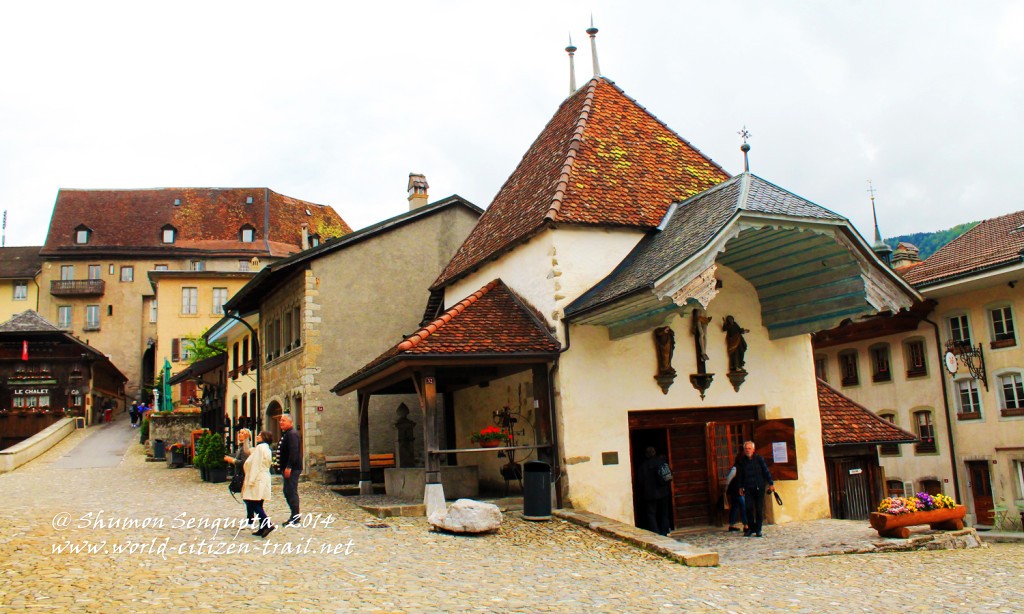
We spent the afternoon, leisurely and aimlessly strolling in the village. On our way back, we made a detour to the northern entrance to the village. This northern entrance, which has a series gates, was the original and only entrance to the village. To reach this entrance from the town square, you first cross an arched gate (next to the central fountain) to enter a courtyard. From there you go through another fortified gate (with watch towers) to exit from the village. And there is a quaintly beautiful cobbled pathway along the stone walls.
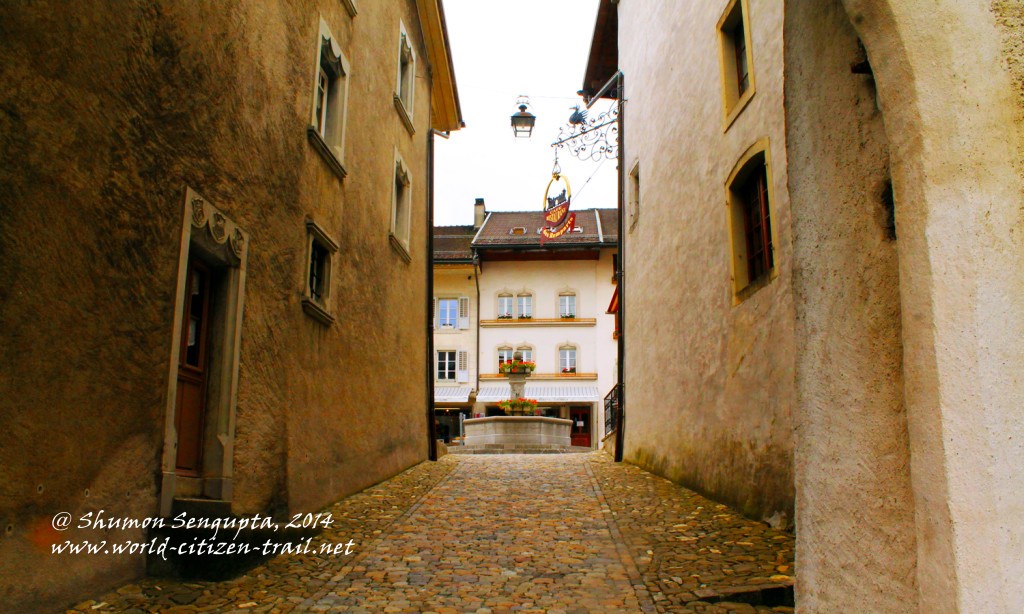
The coat of arms of Gruyères depicts a Crane bird (Grue means Crane in French) and we found this exquisite image of the bird painted or sculpted on facades of many buildings.
For those who love outdoor activities, there are many options available in this place. You can hike up to the nearby Mont Moléson or go for hand-gliding or rafting. And about 18 kilometers from Montbovan, along the left bank of the Sanne river, there is a trail called the “Trail of the Counts”. With a walking time of around six hours, this scenic trail passes through seven quaint villages, with historic houses and chapels.
Apart from small hotels, a good option for accommodation in this areas are farm houses, which generally offer farm fresh breakfast and beautiful views of the valley.
Nestled in the alpine foothills, and perched on top of a hill overlooking a vast verdant valley, Gruyeres is a truly idyllic place, with a fascinating history. Although we wanted to linger in Gruyères for some more time and explore the surrounding area further, we had to leave in the early afternoon to make a quick trip to the Cailler Chocolate factory in nearby town of Broc Fabrique.
Later in the evening, we took the Golden Pass train in Montbovon for our next destination – Interlaken.
